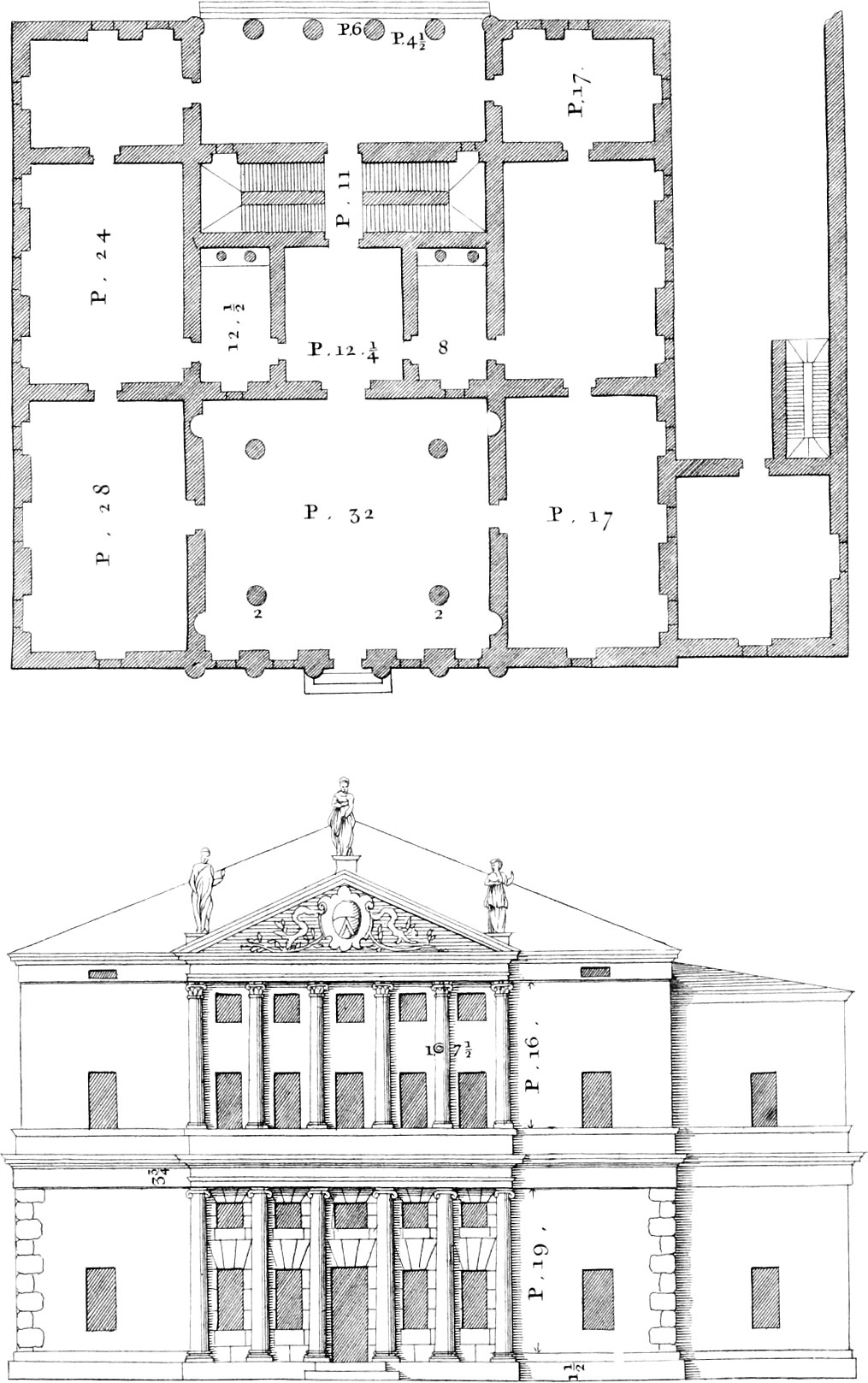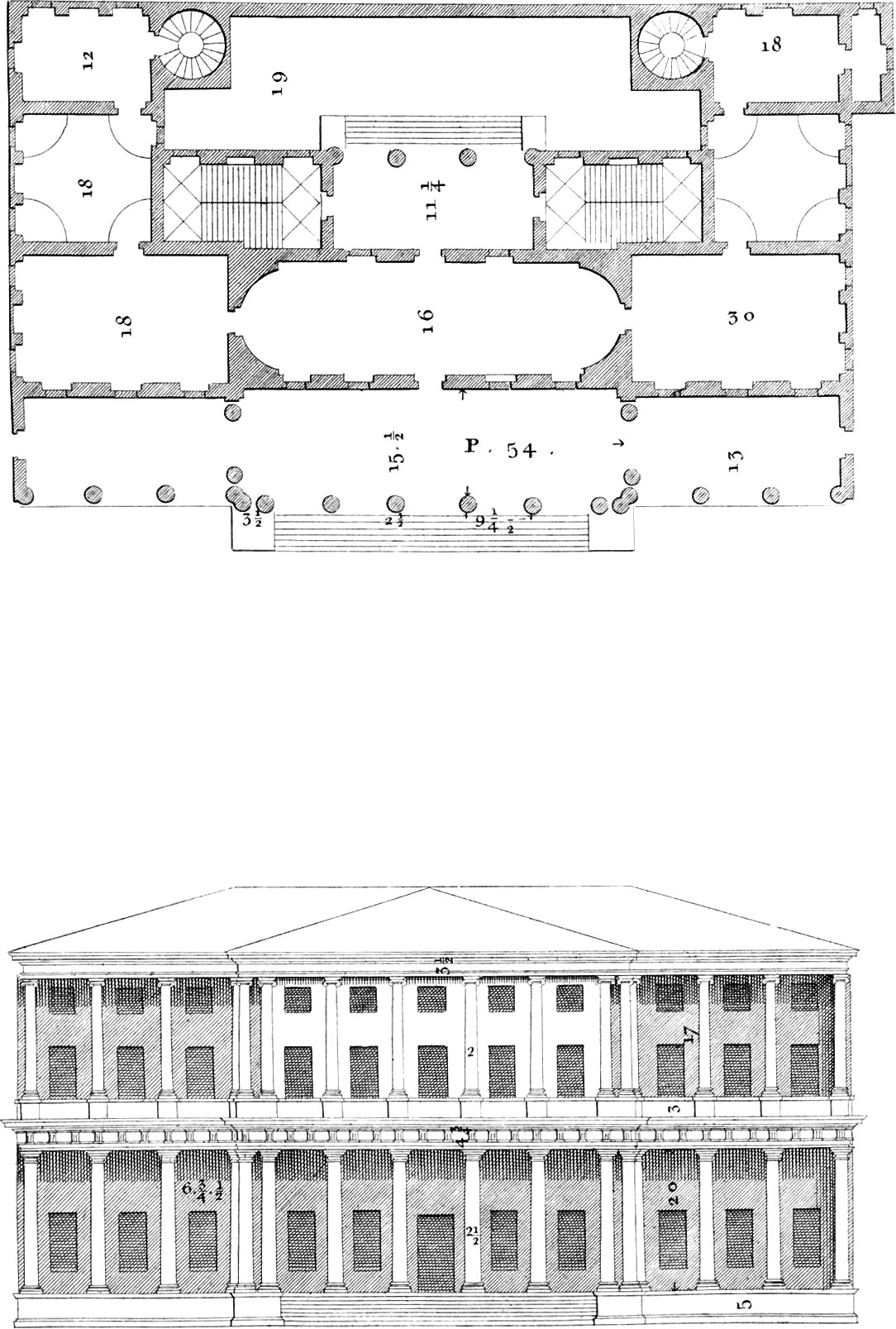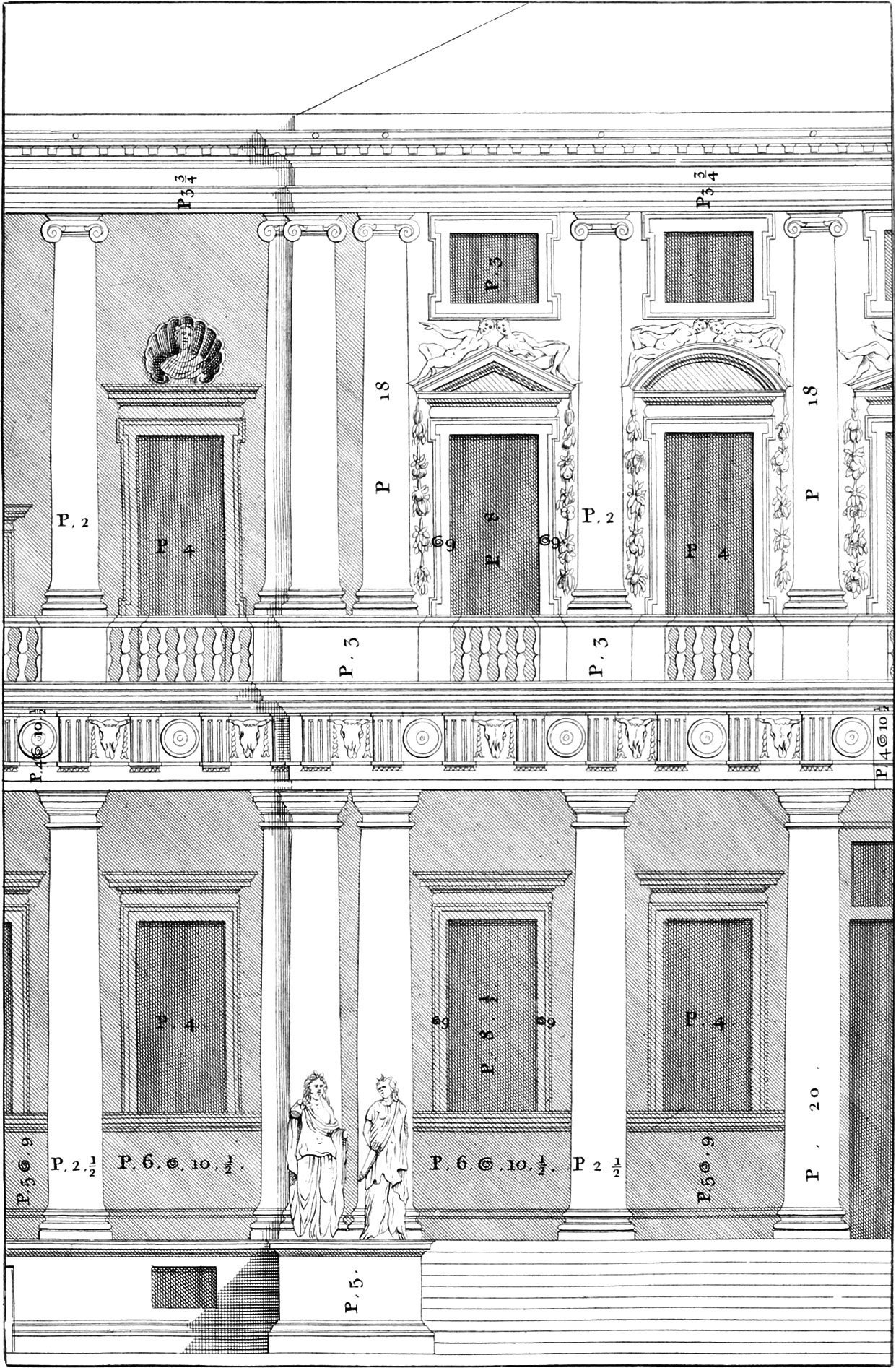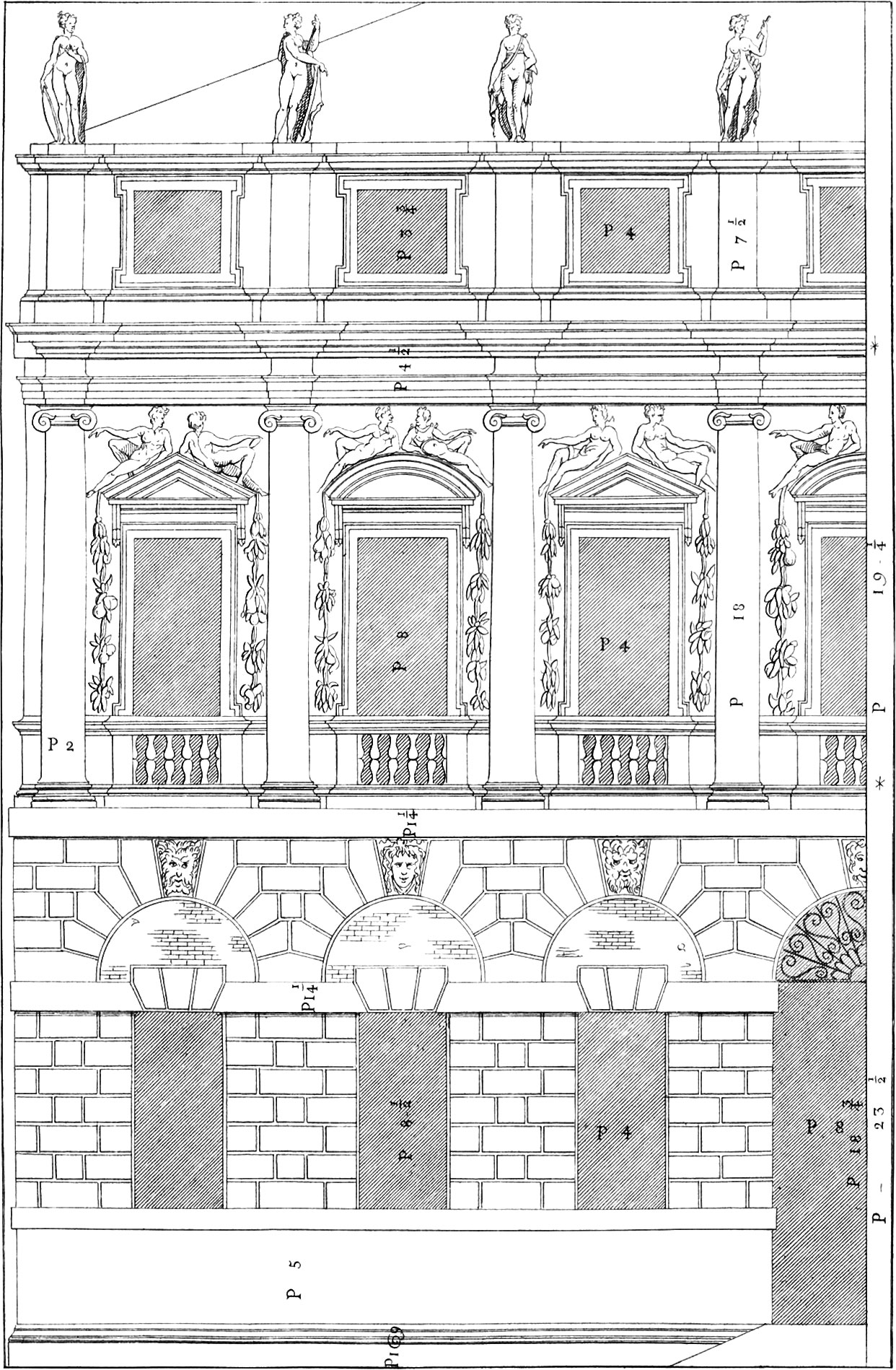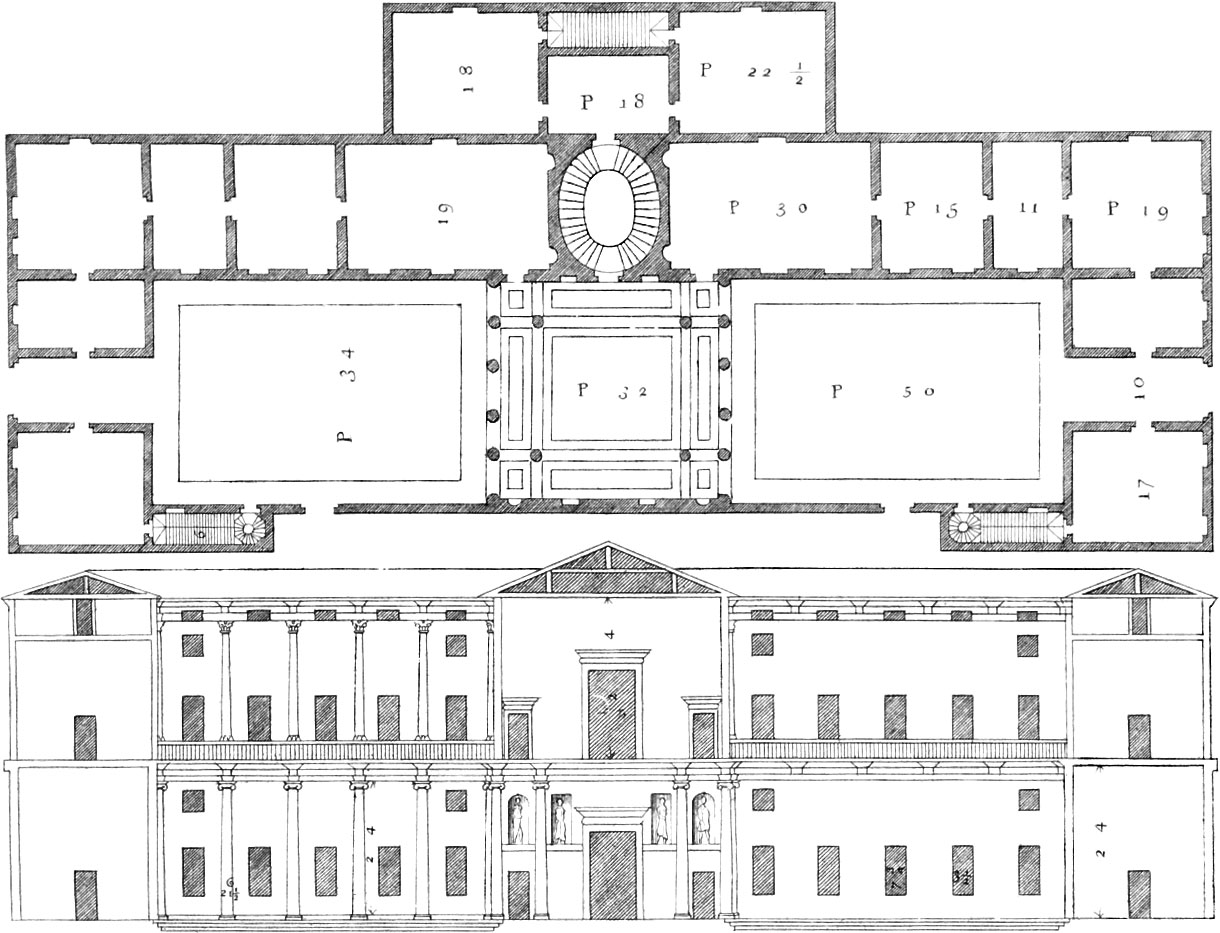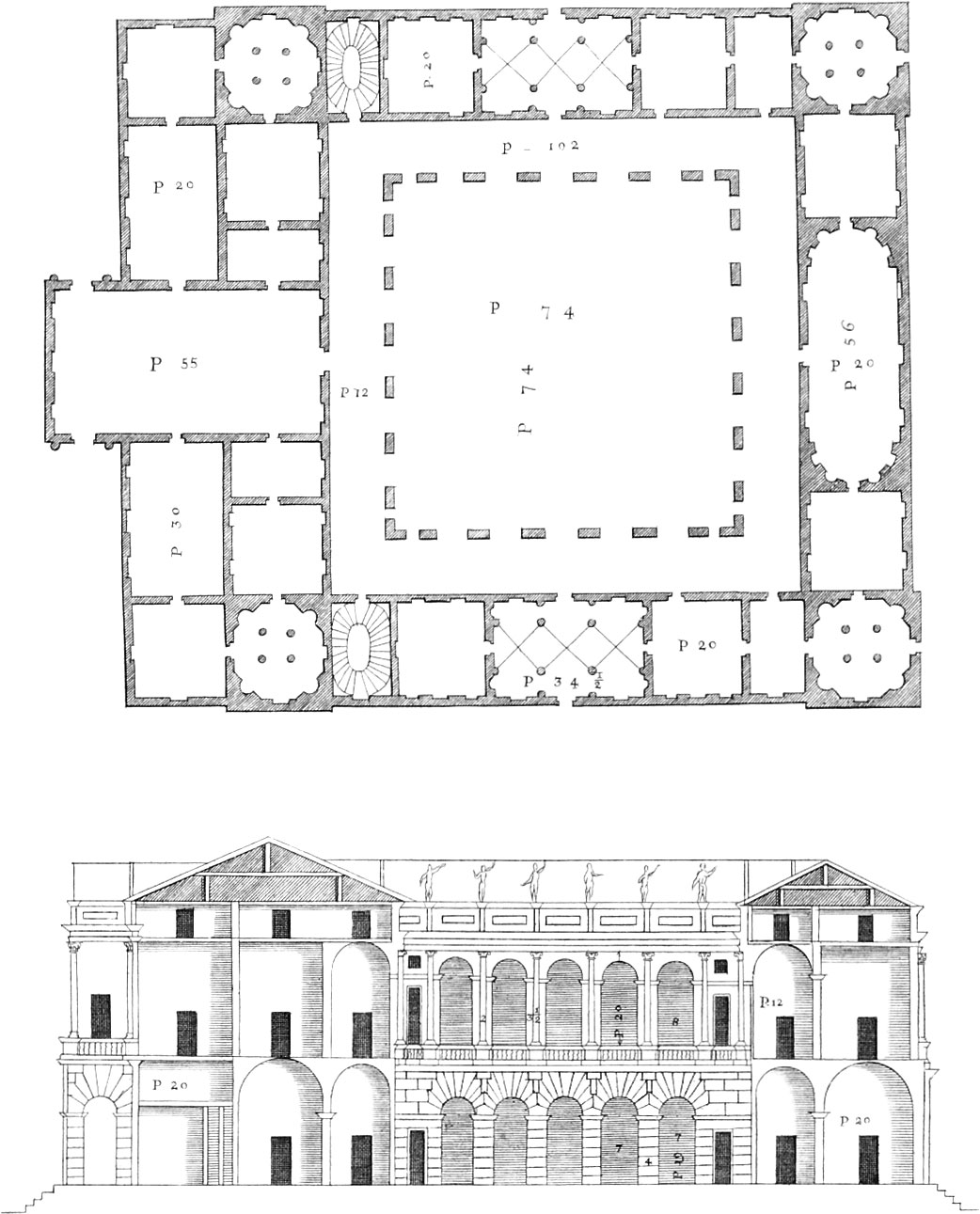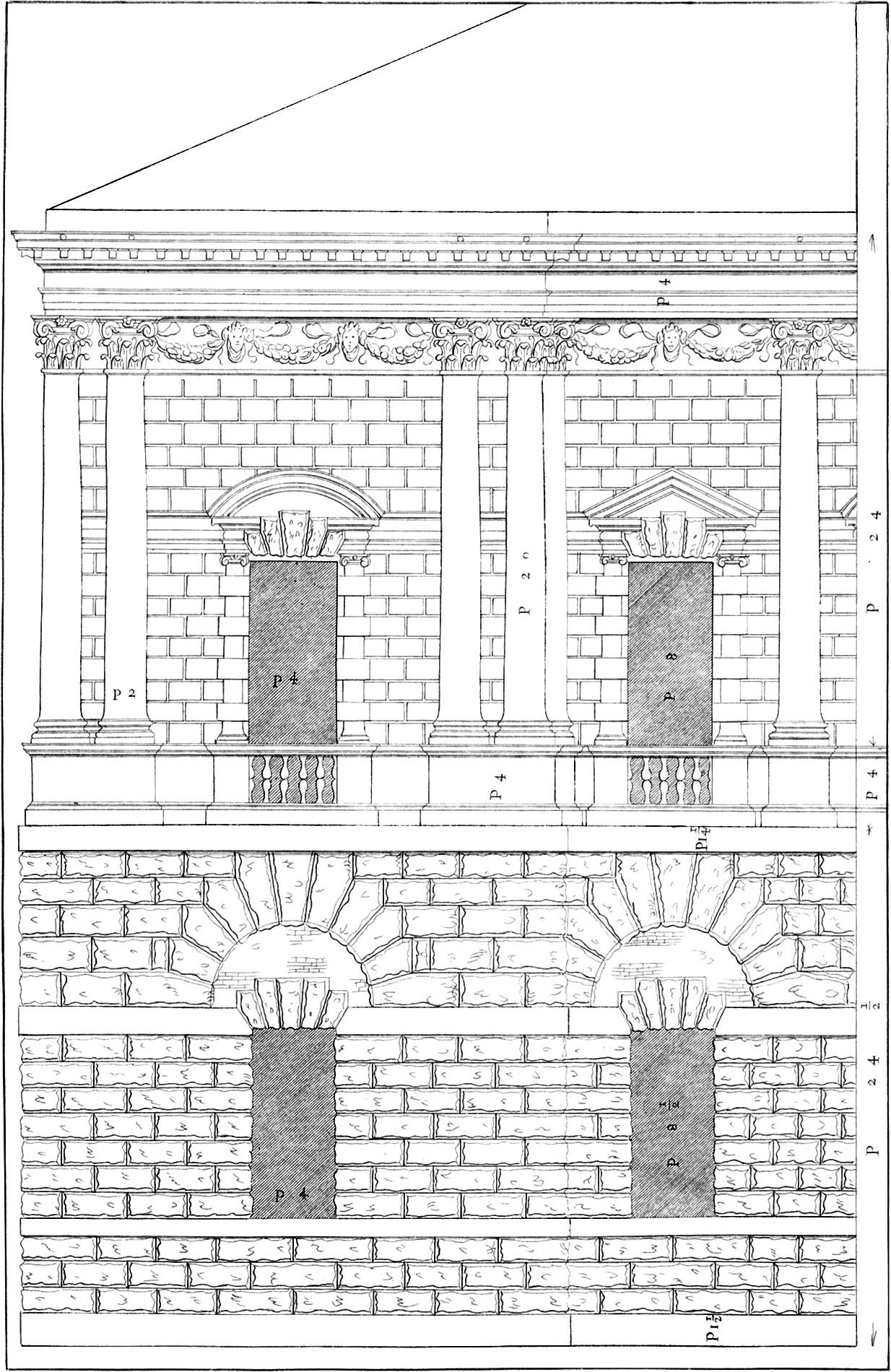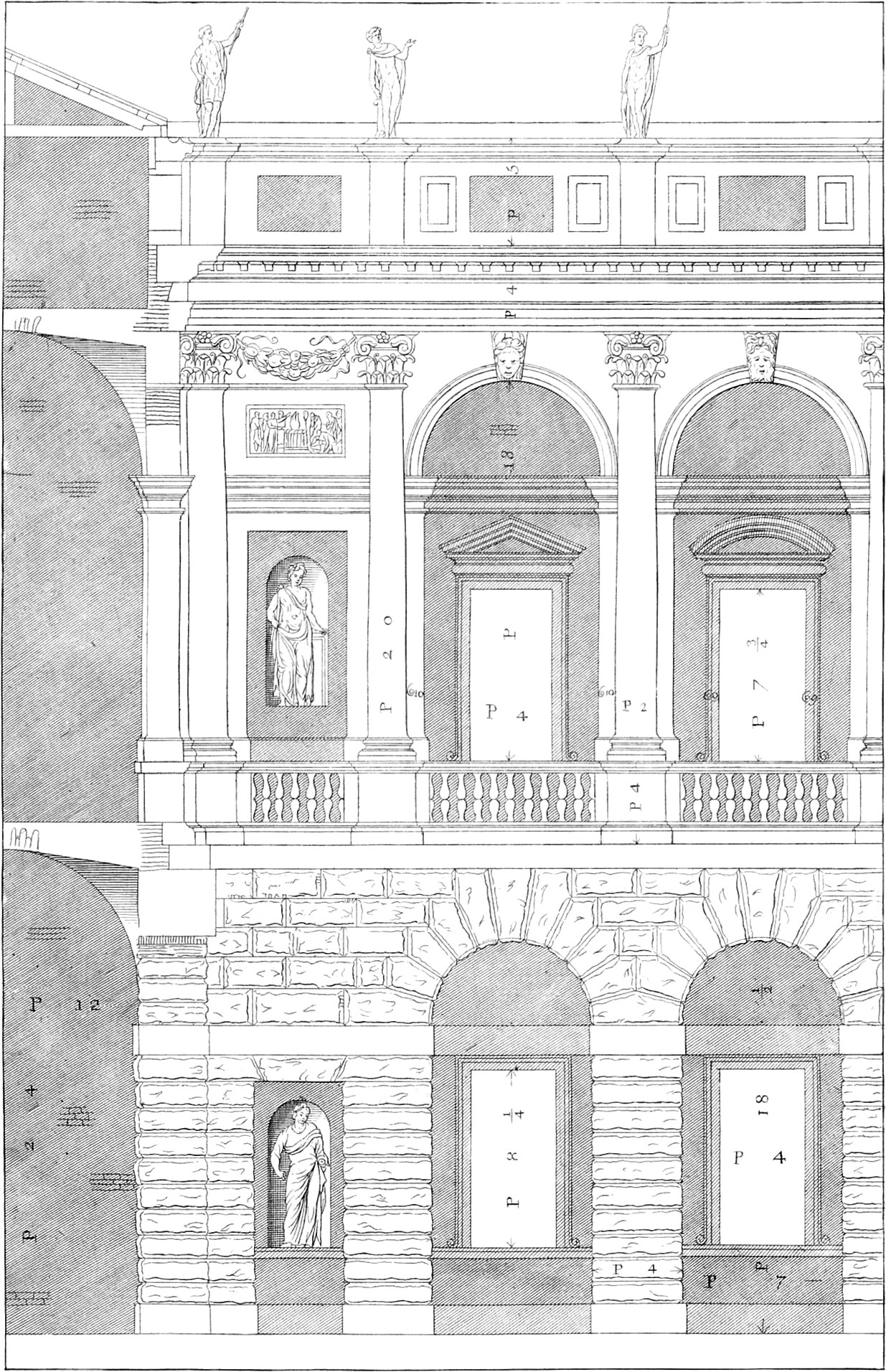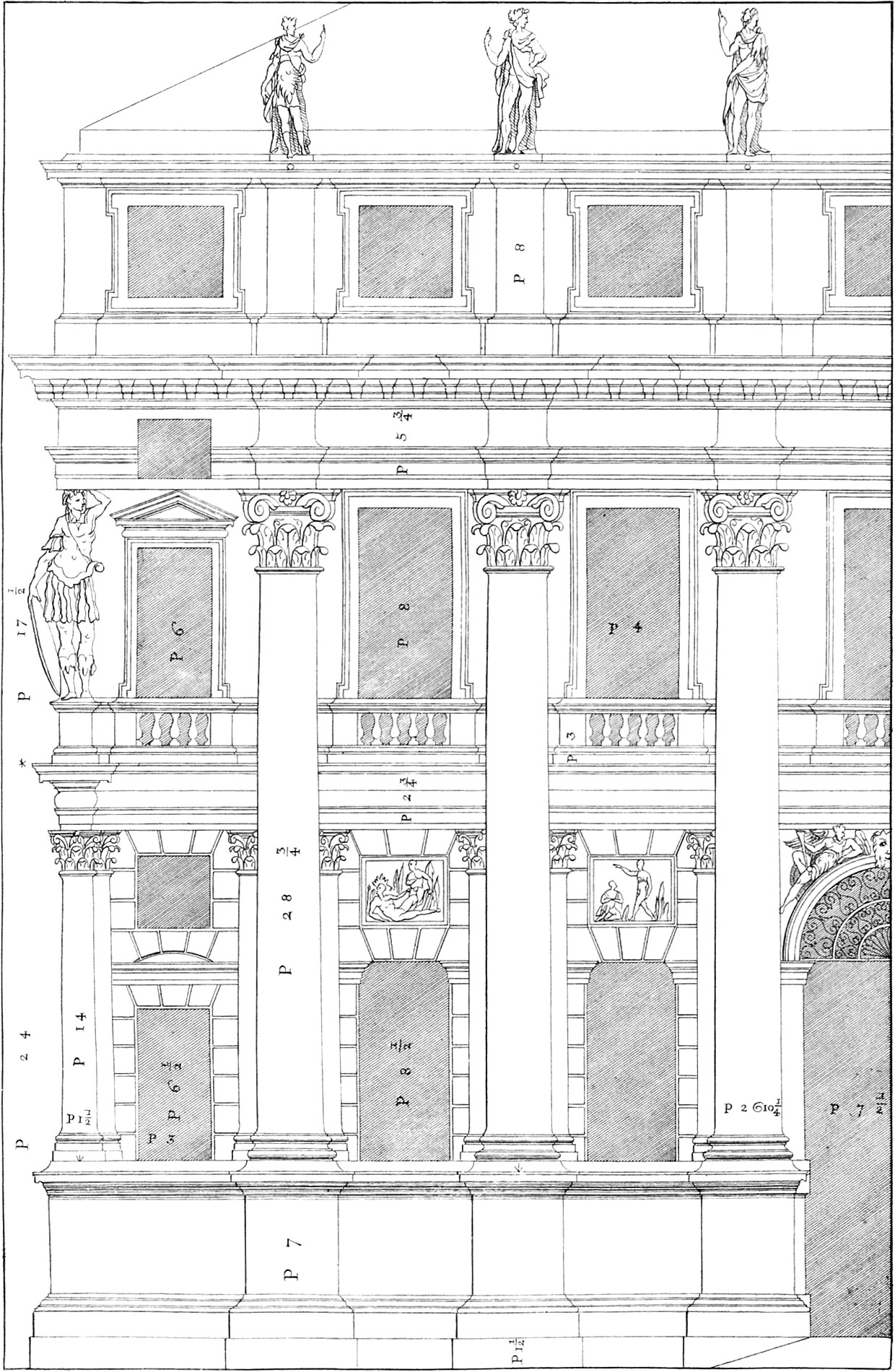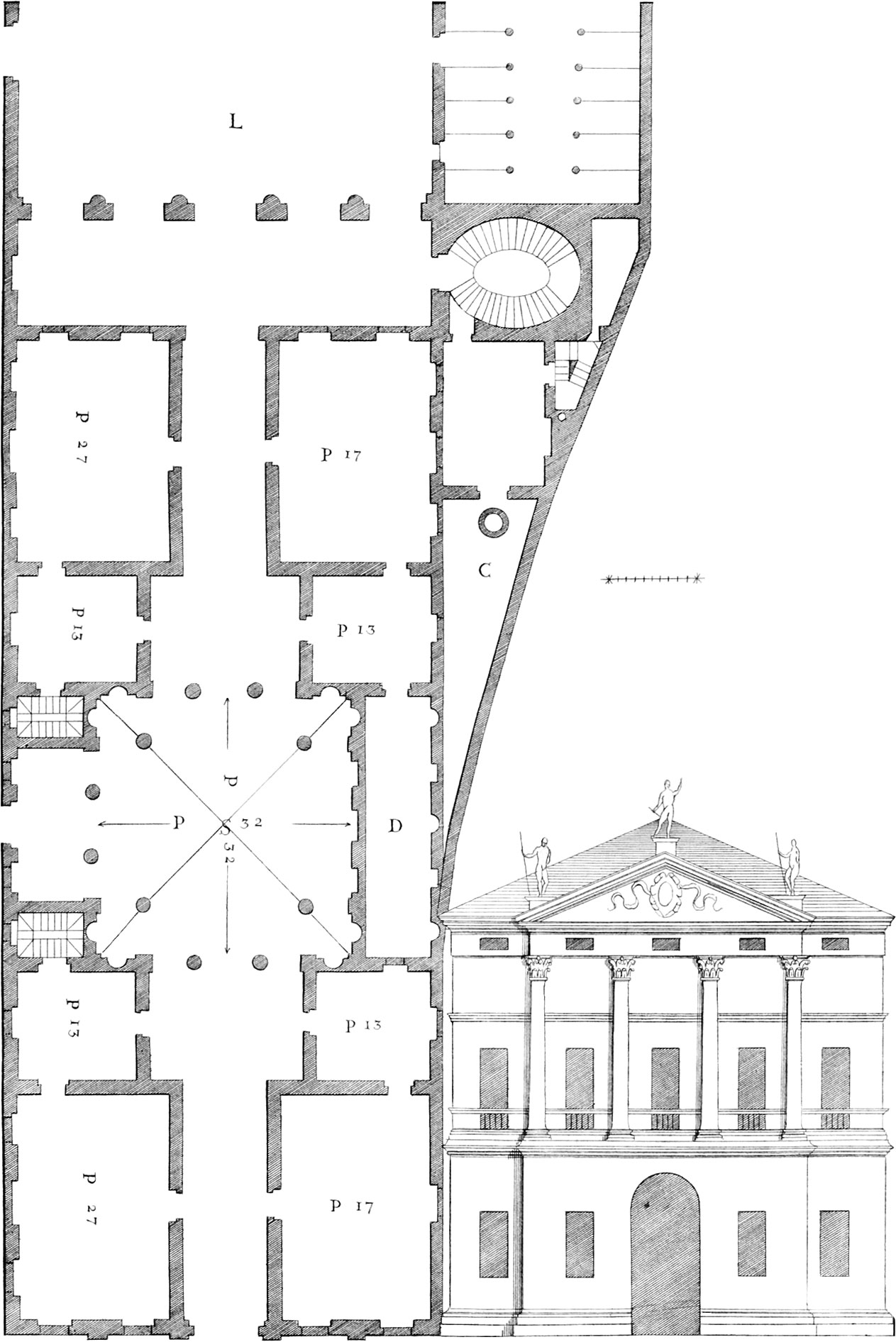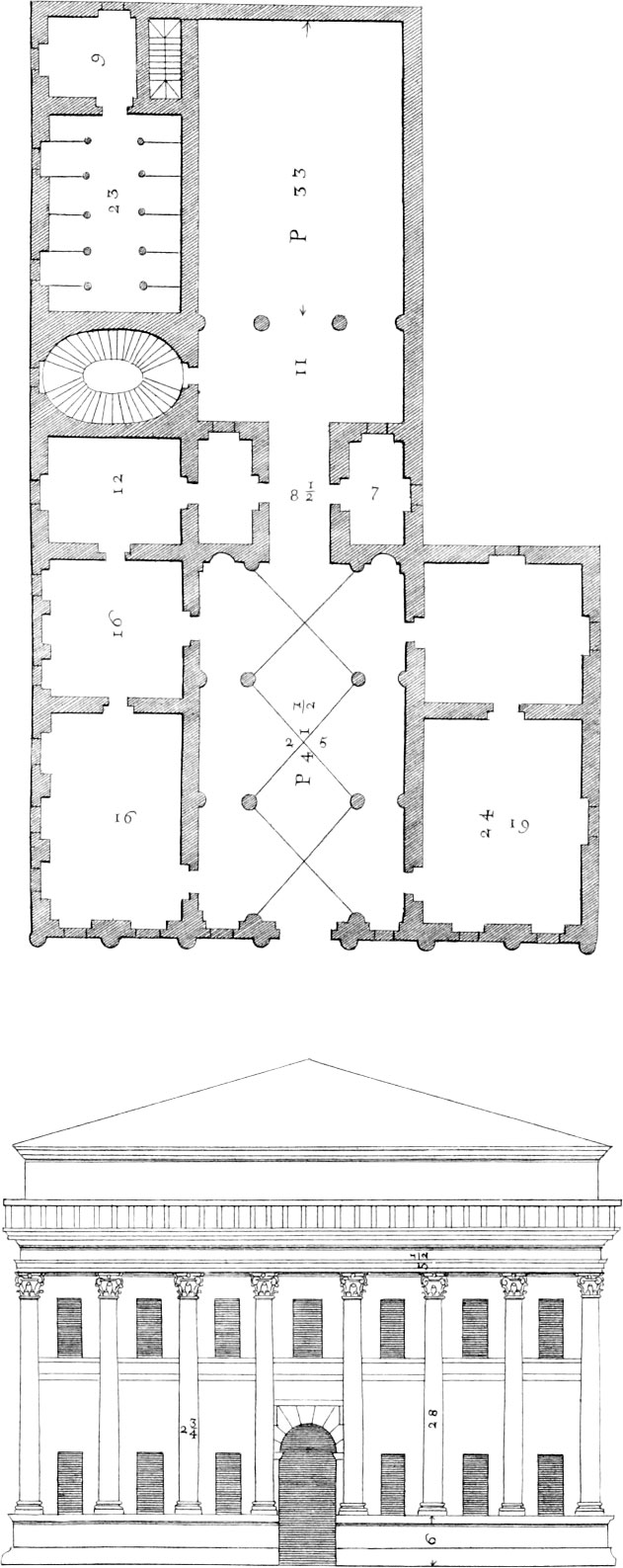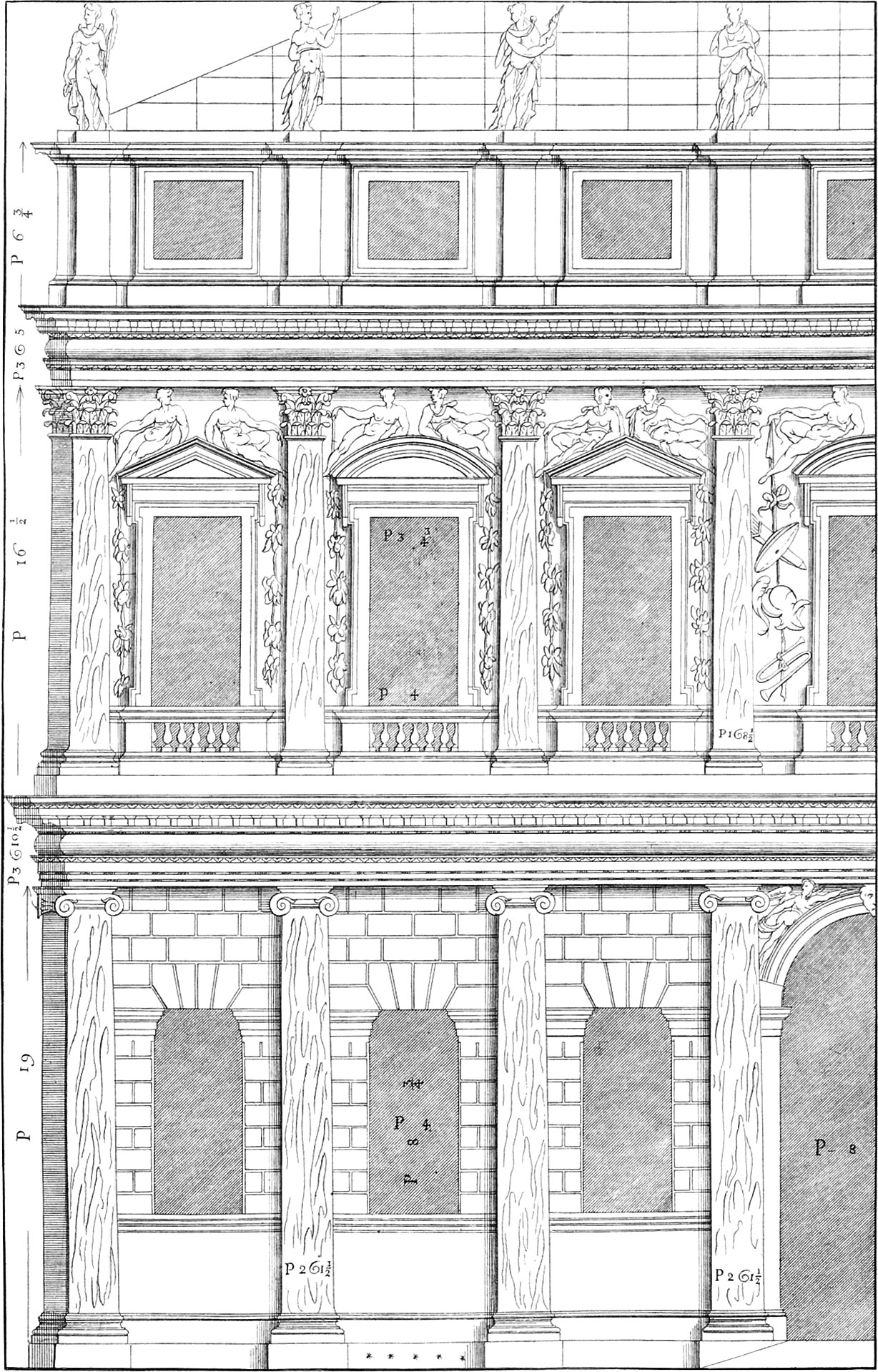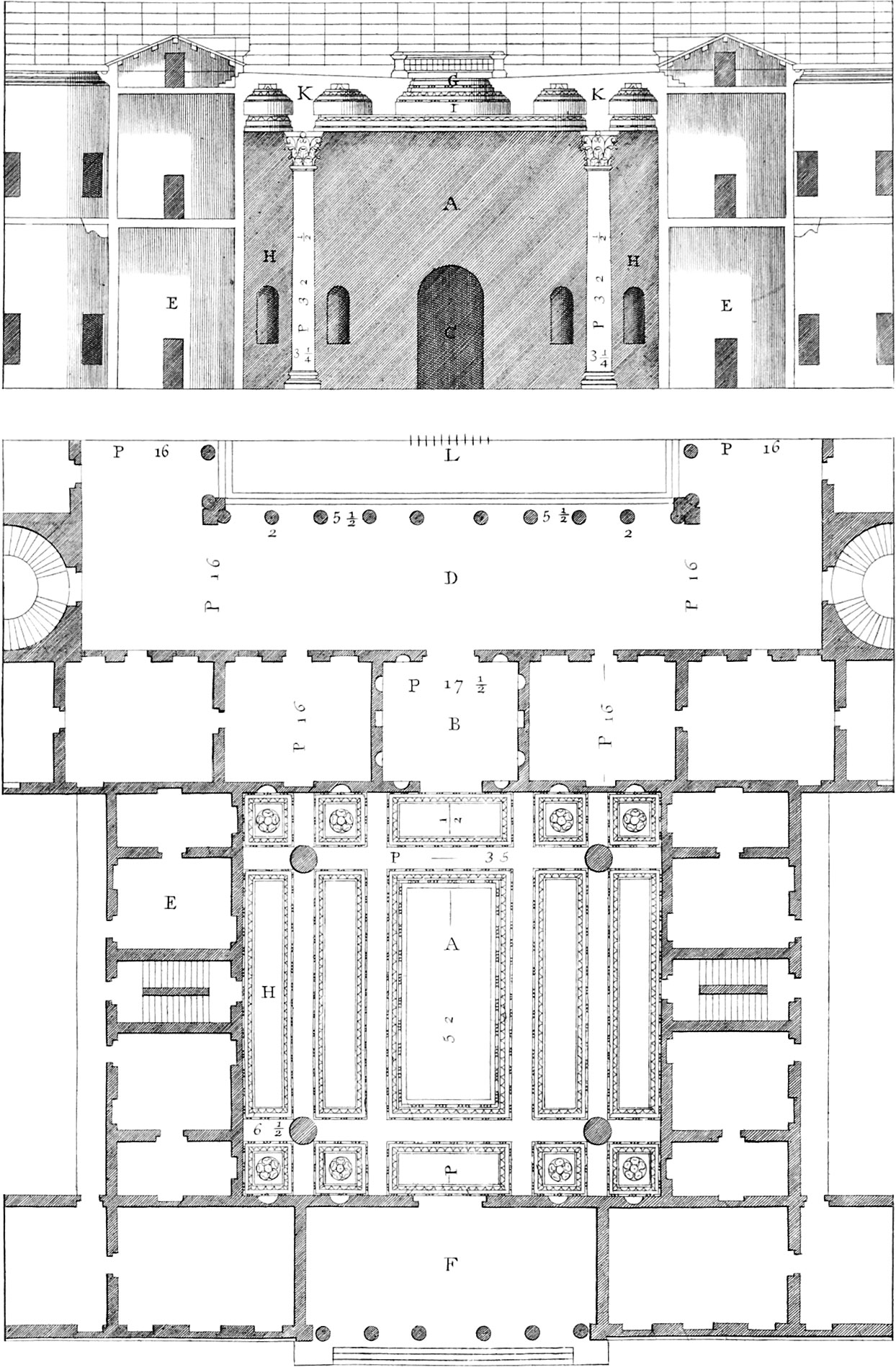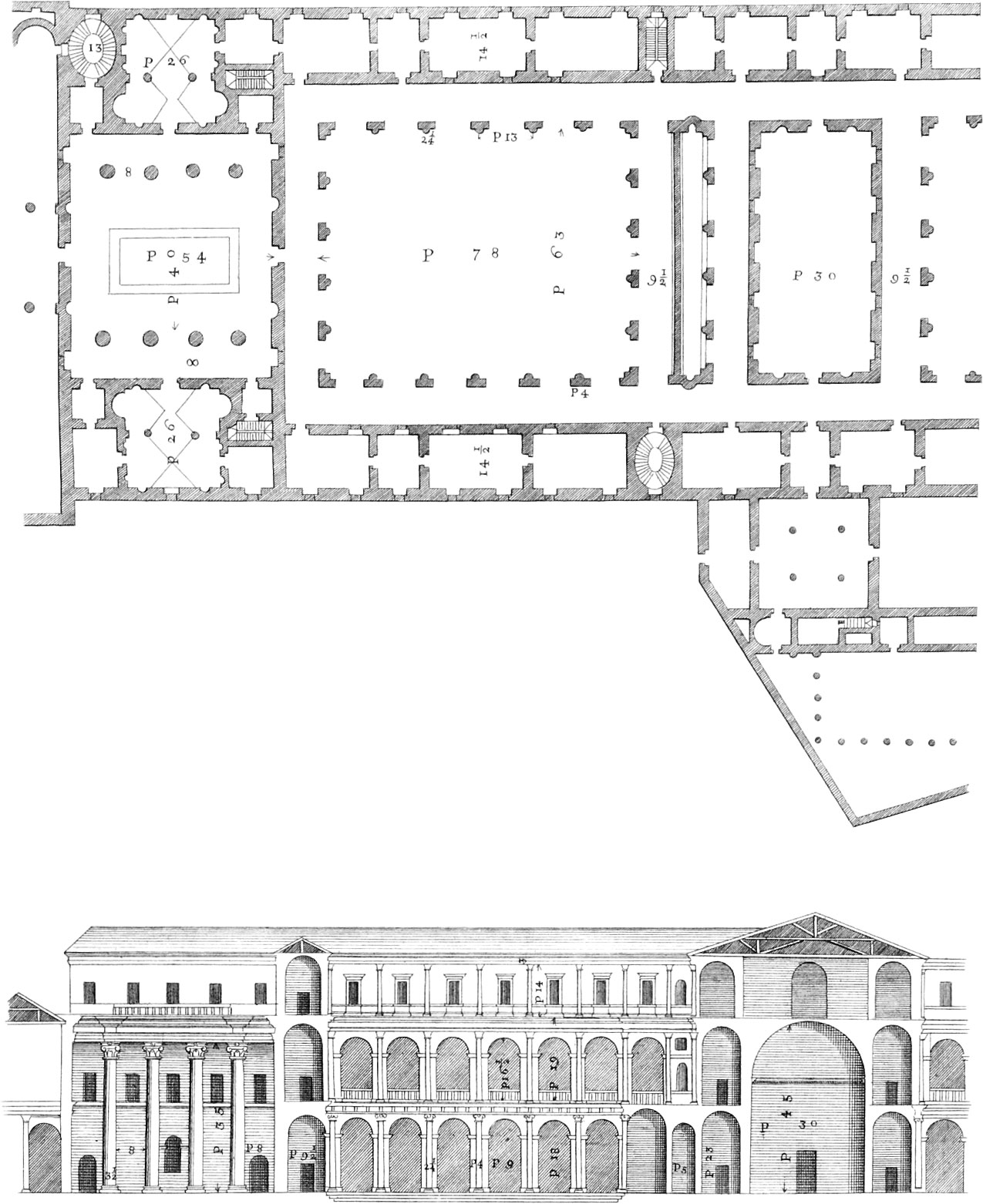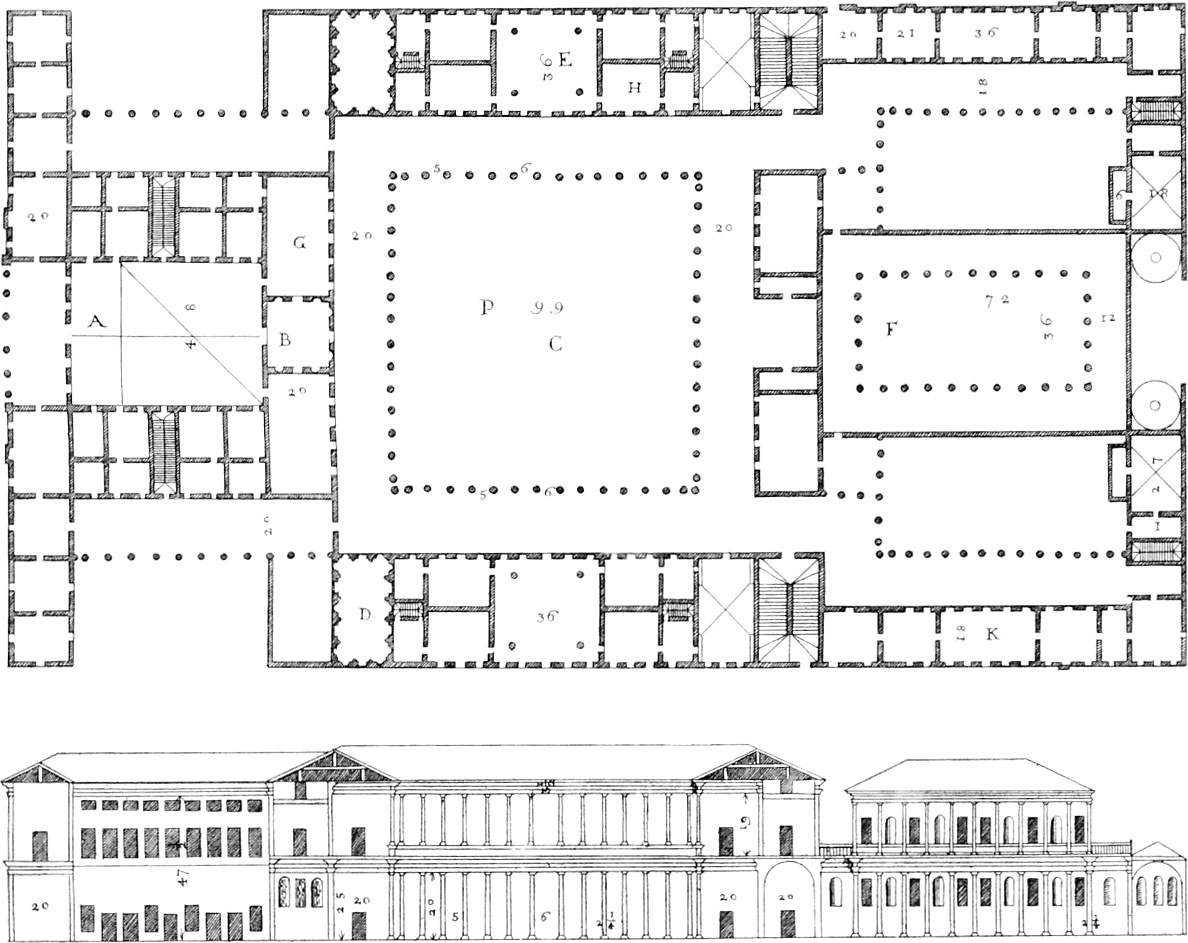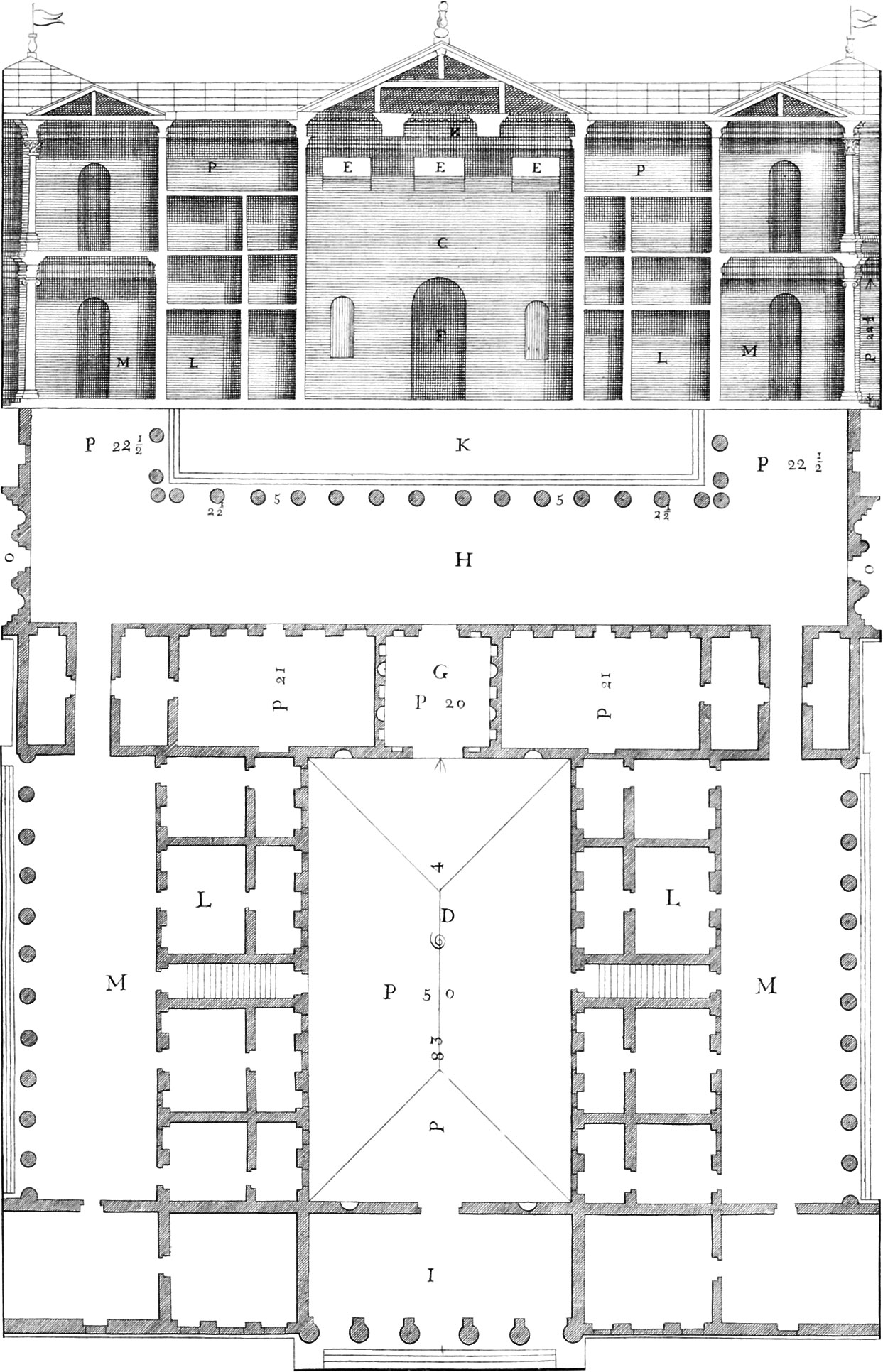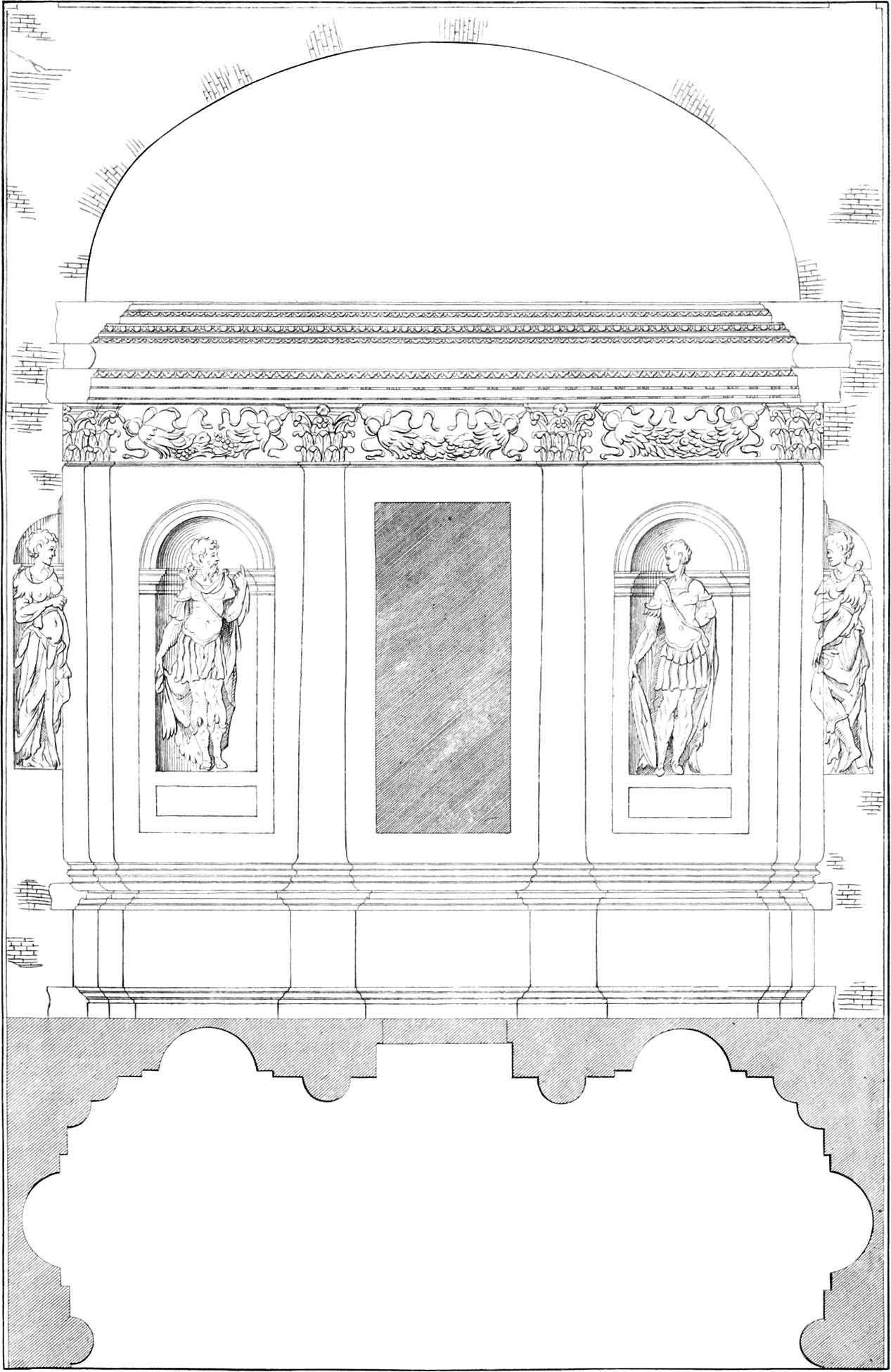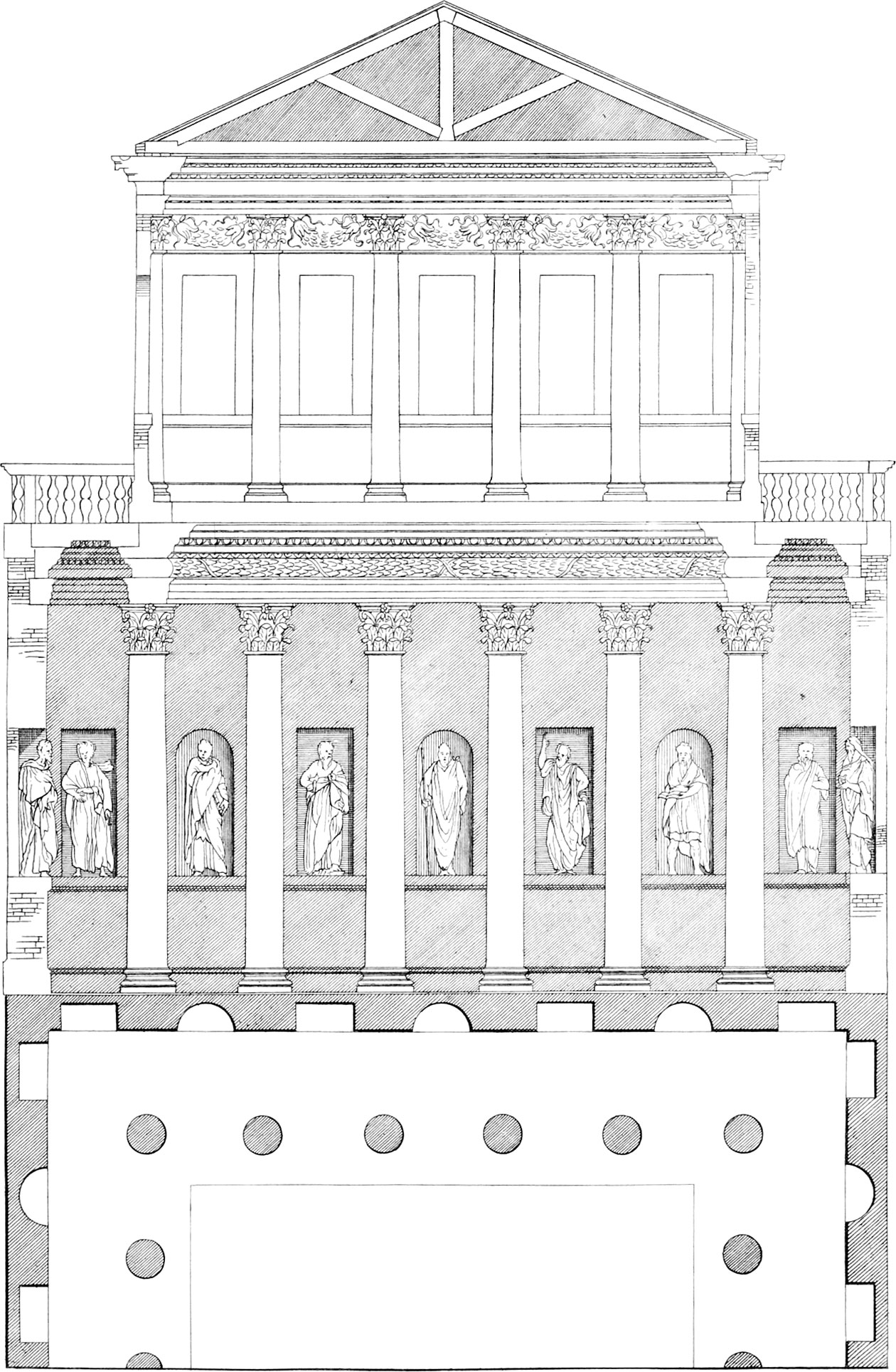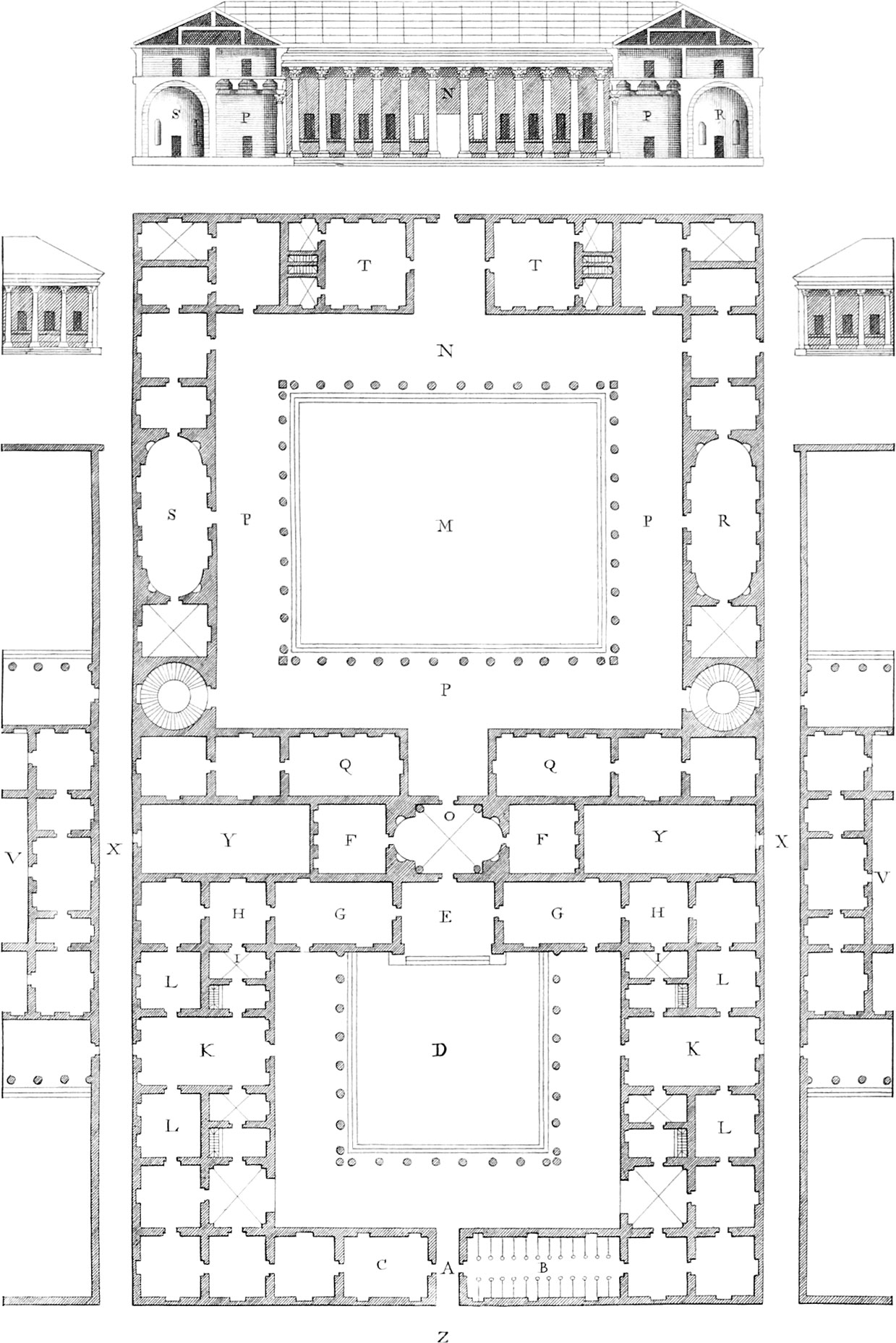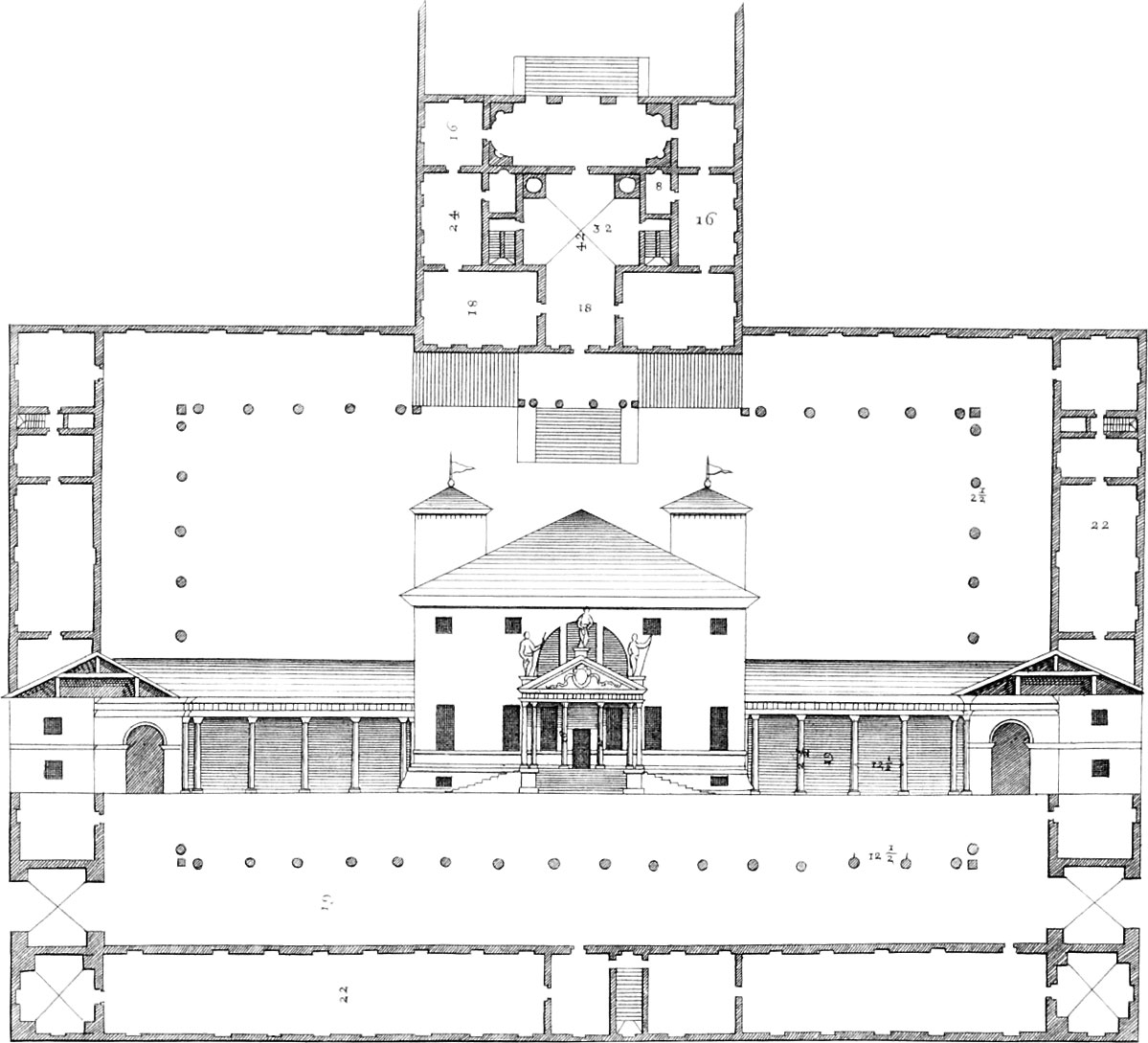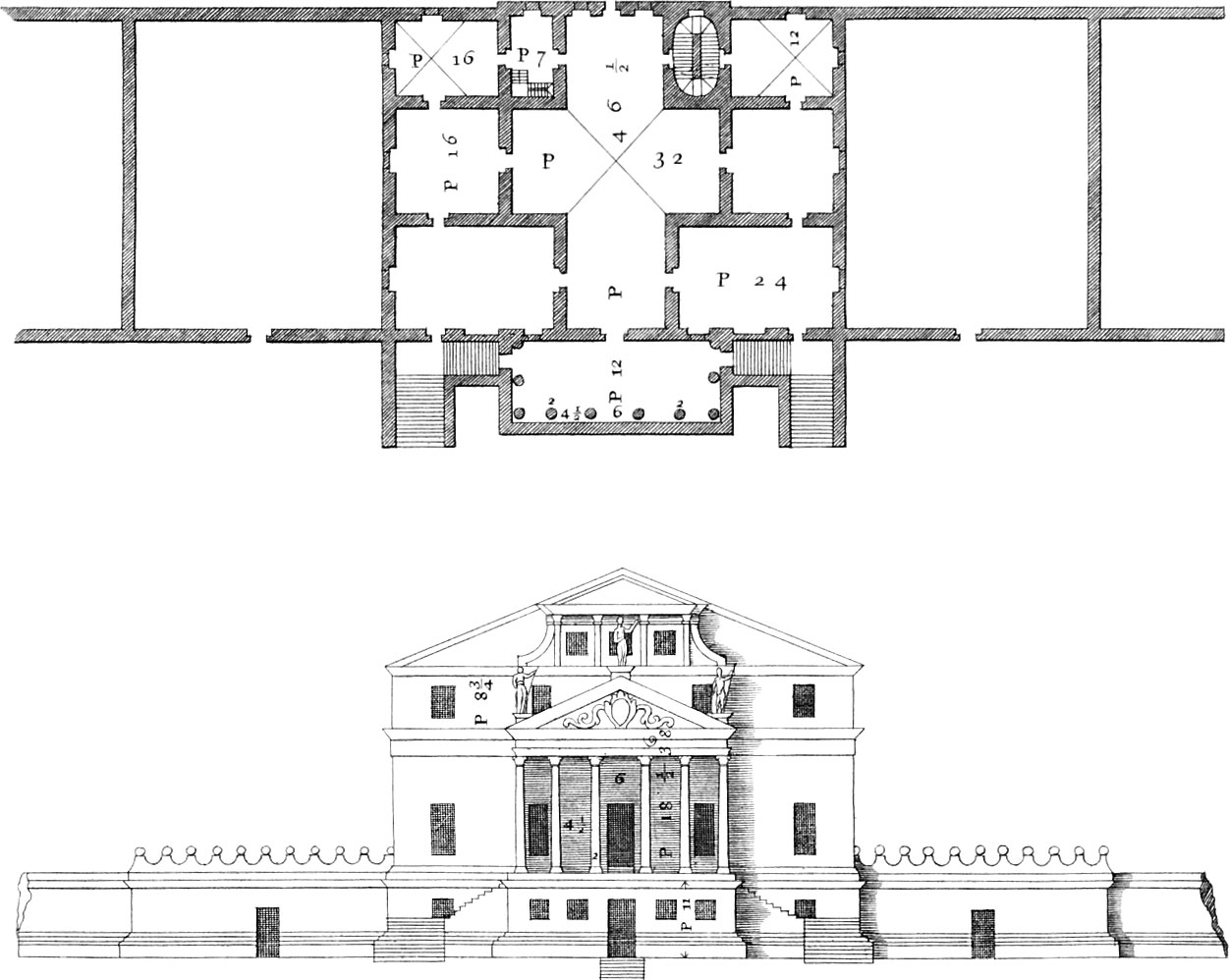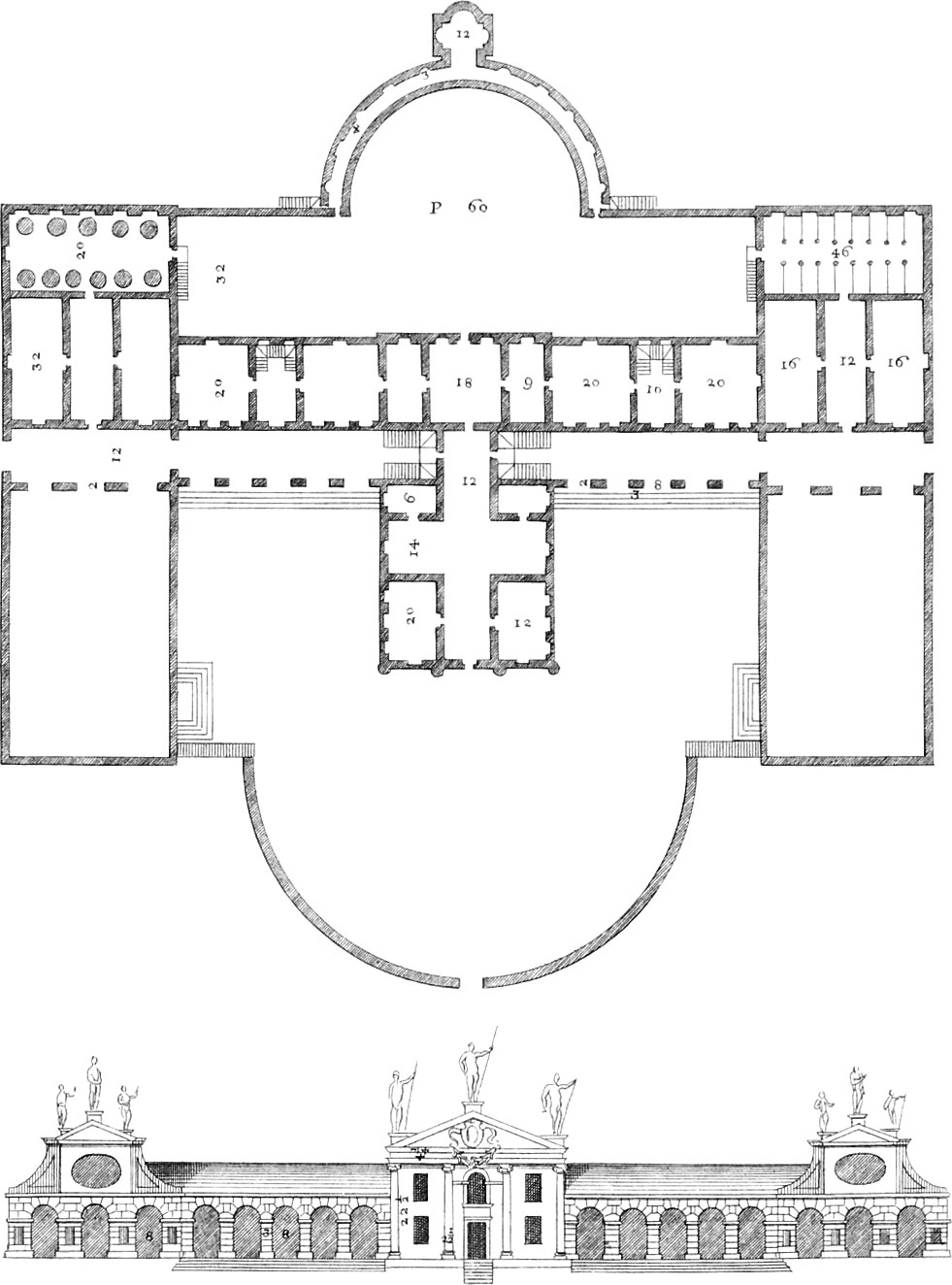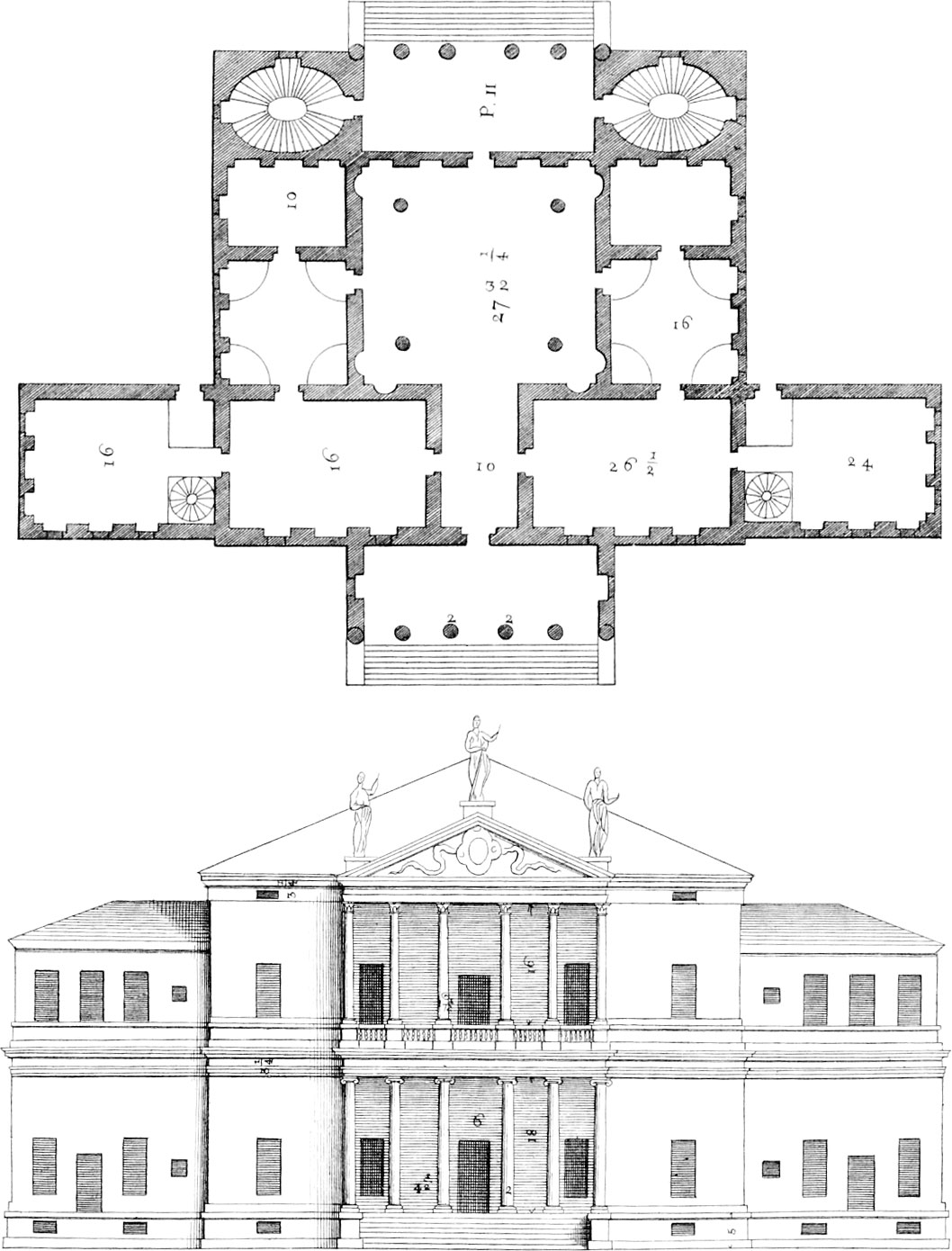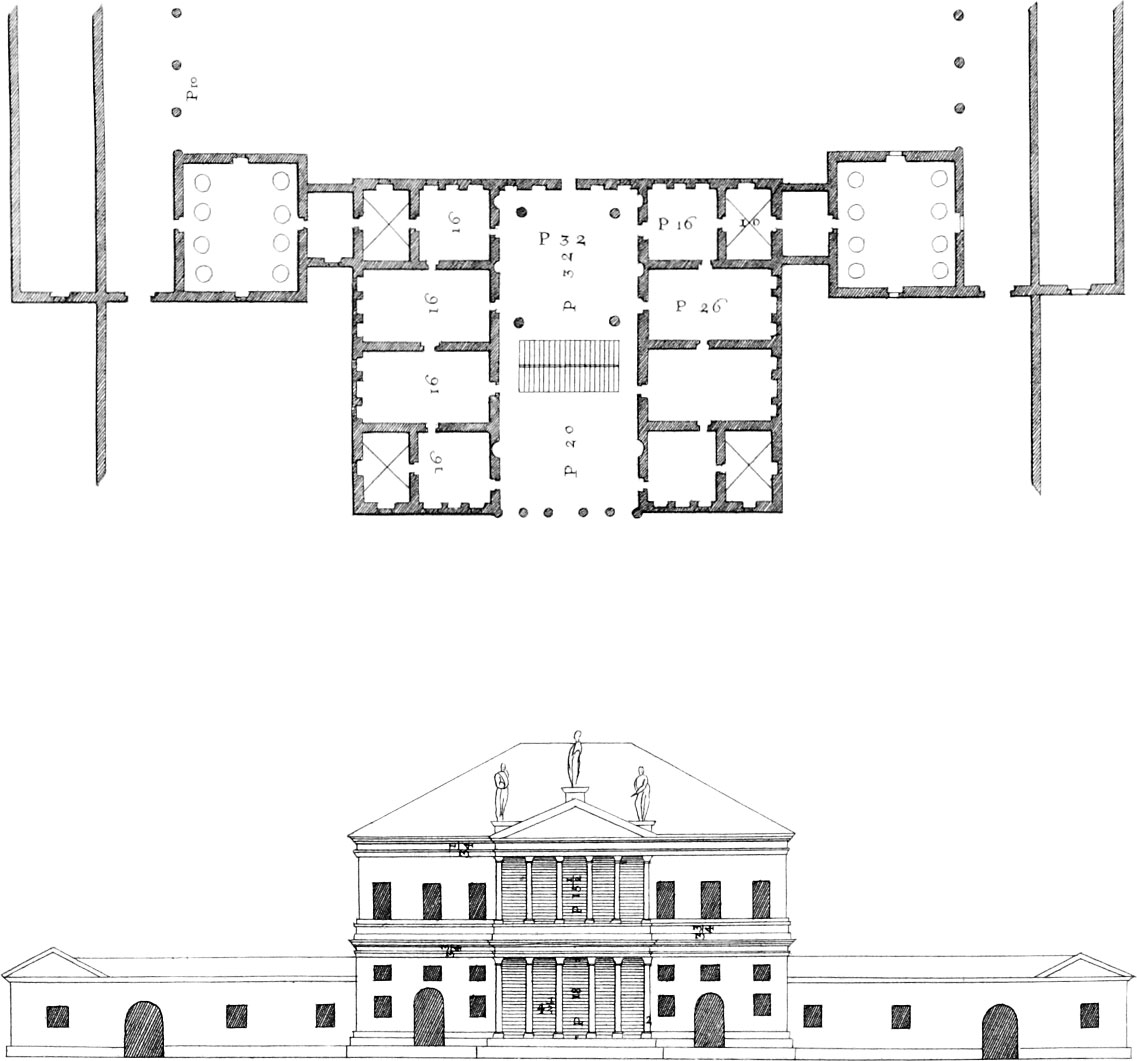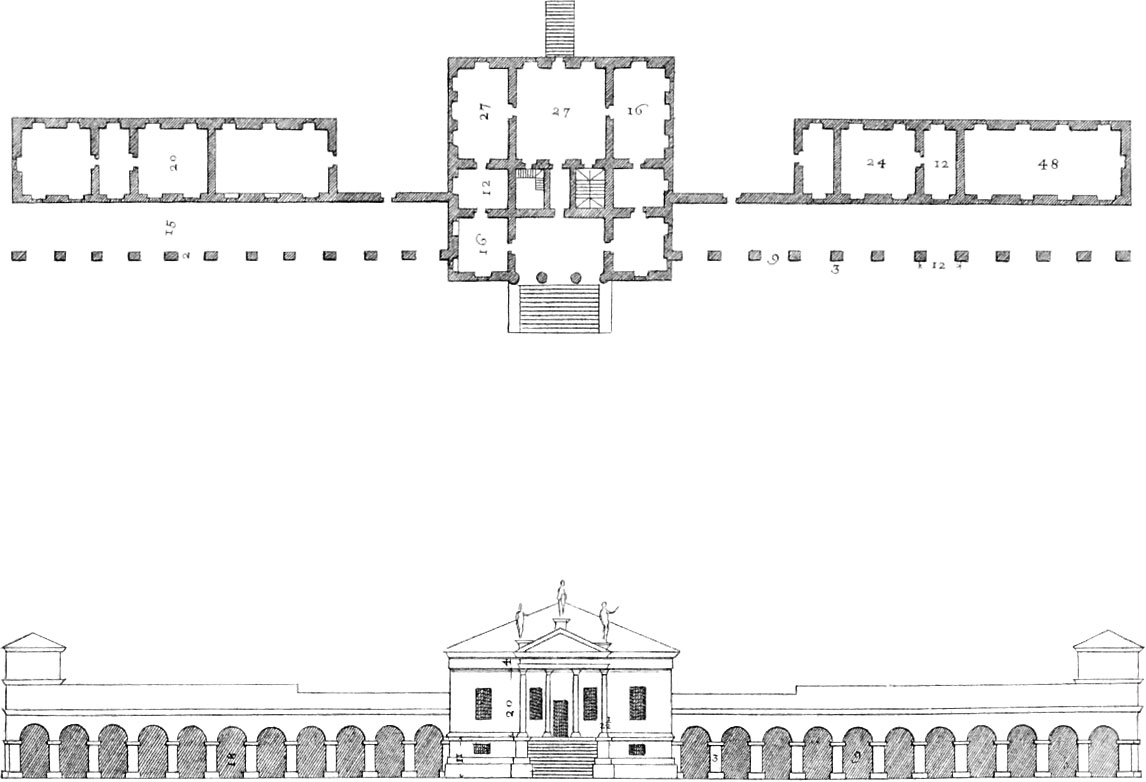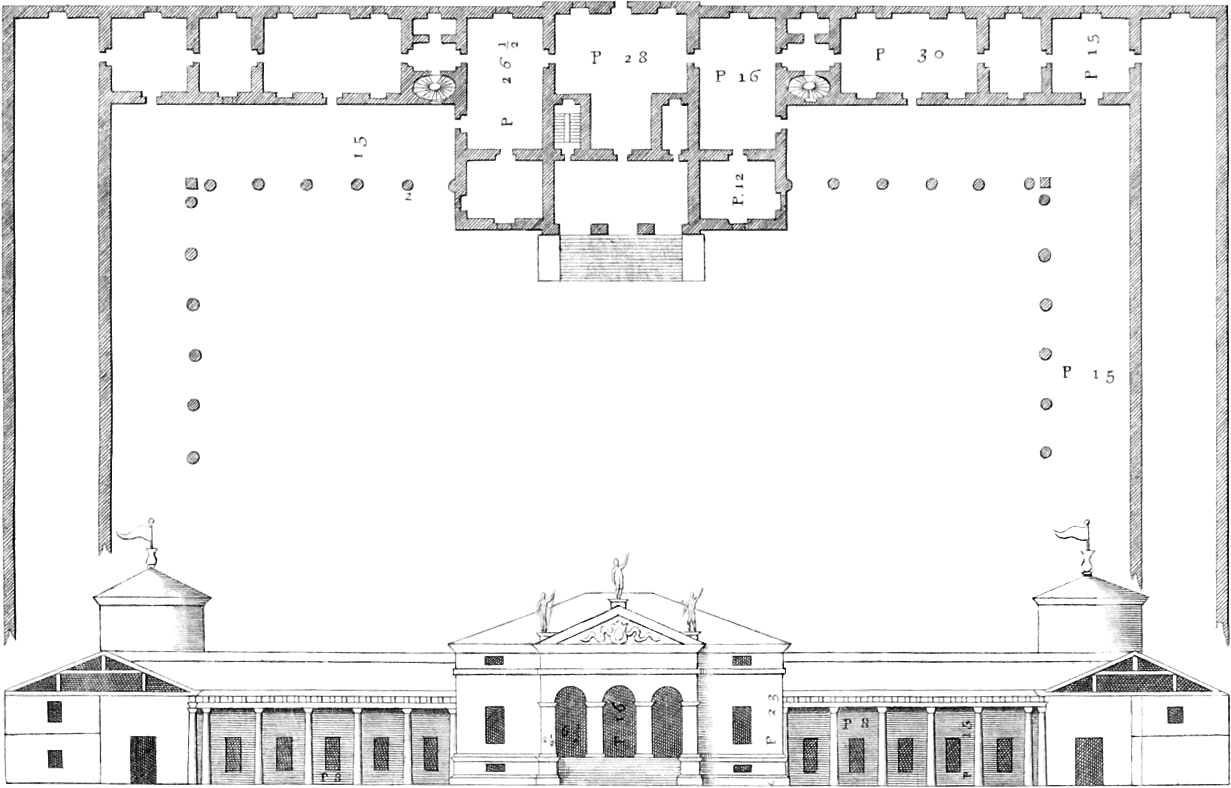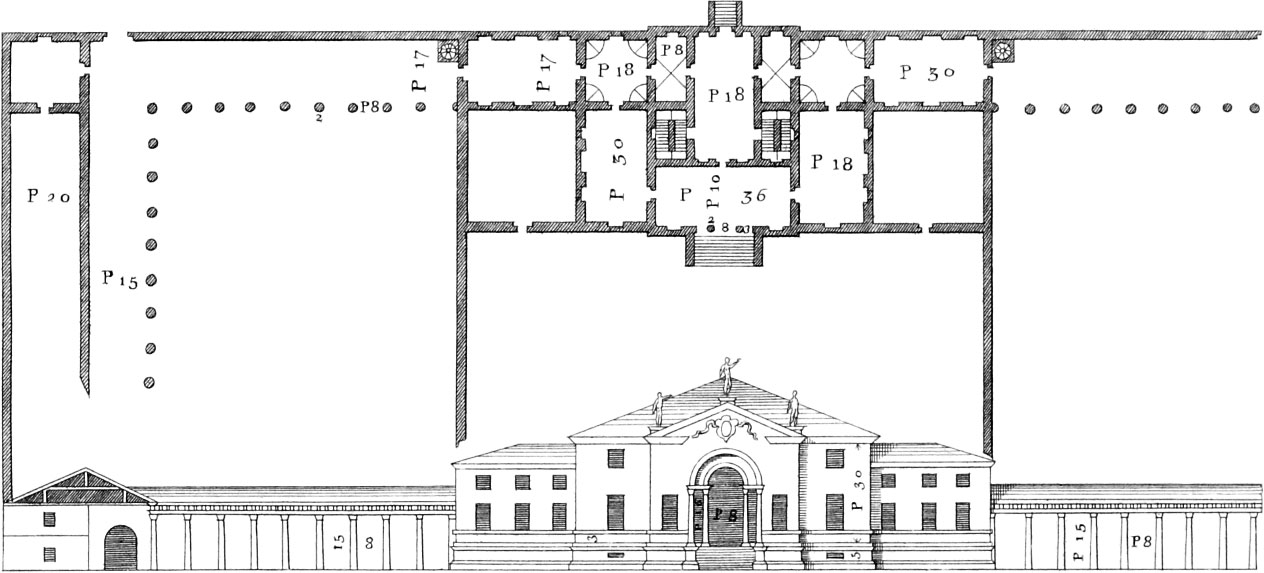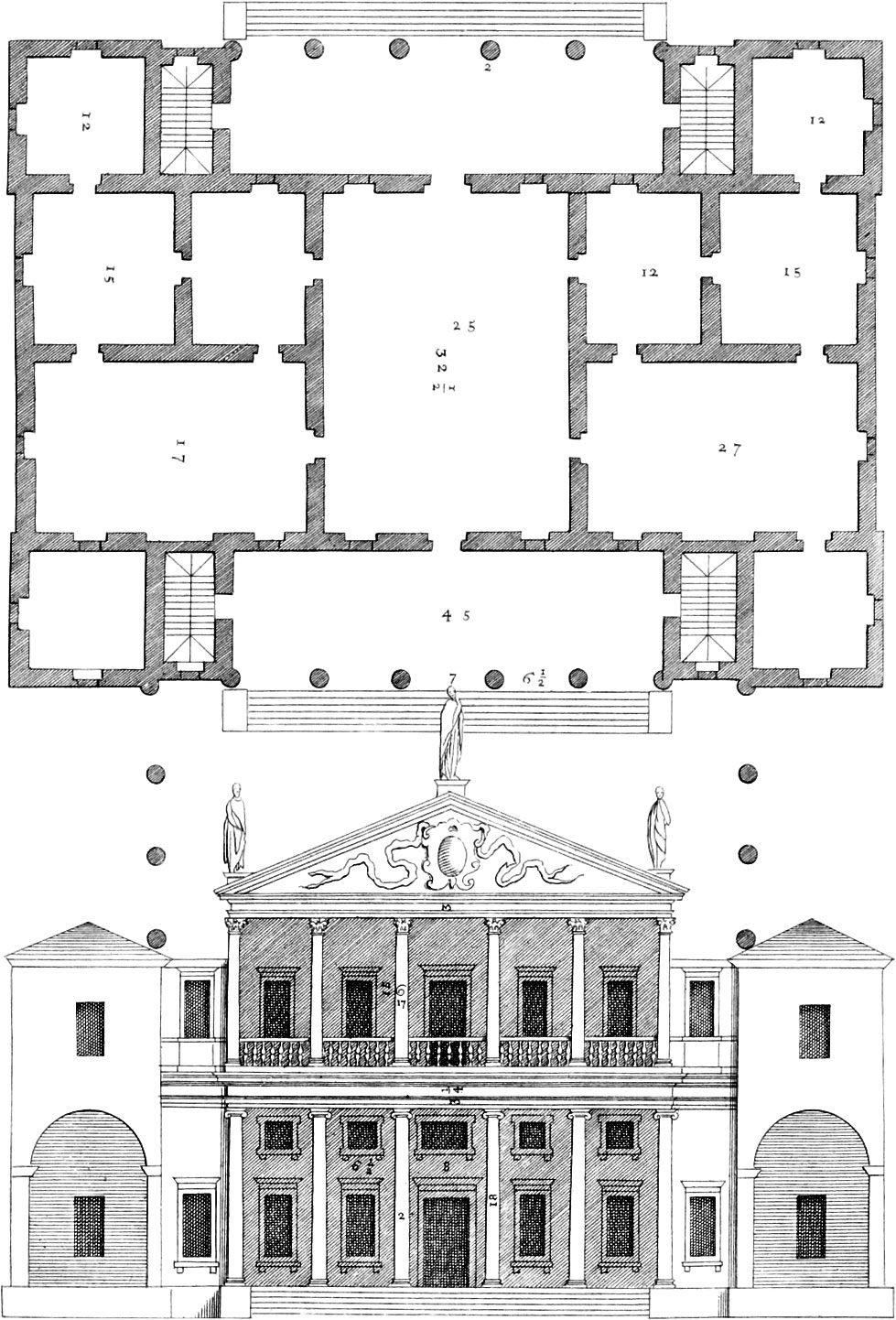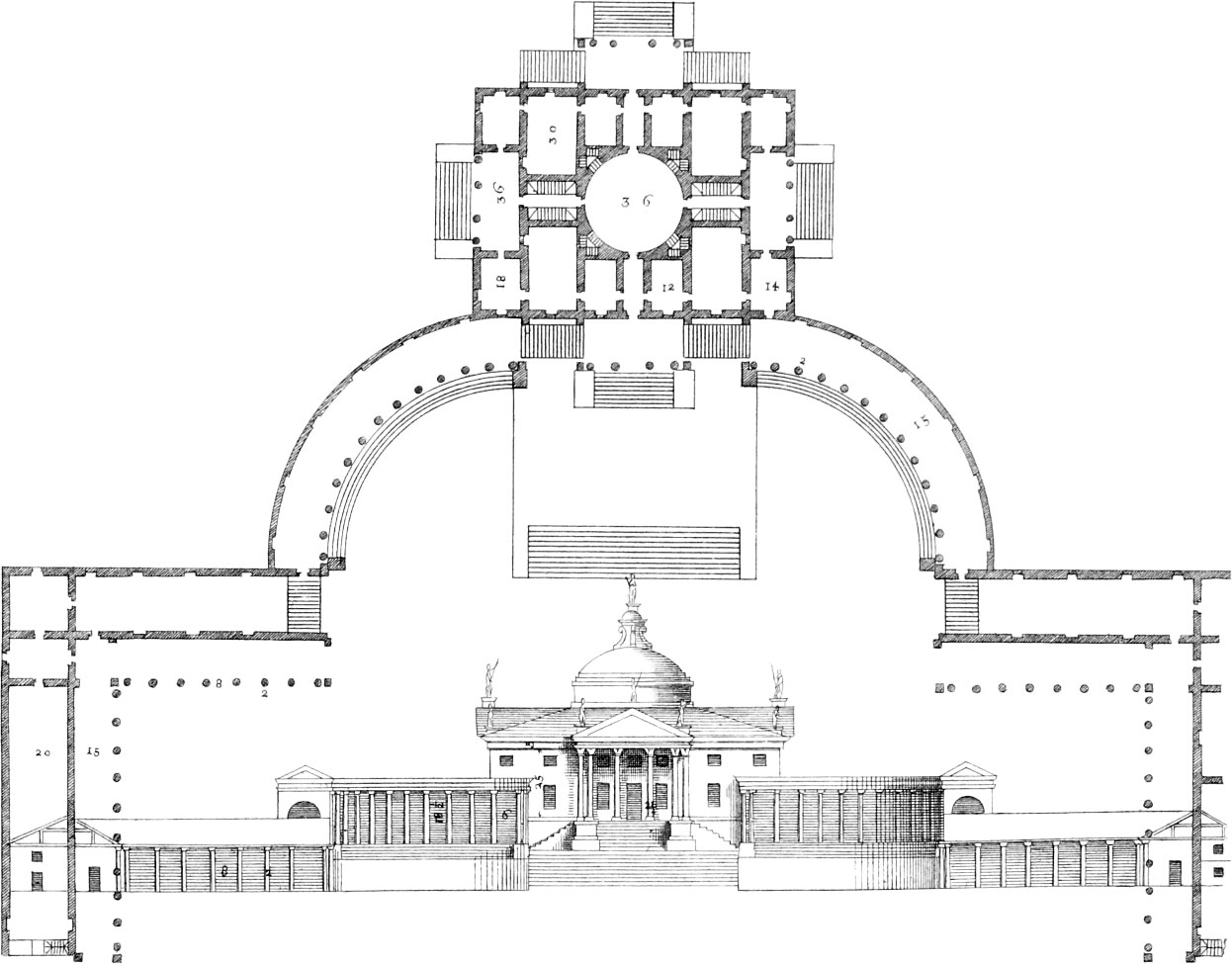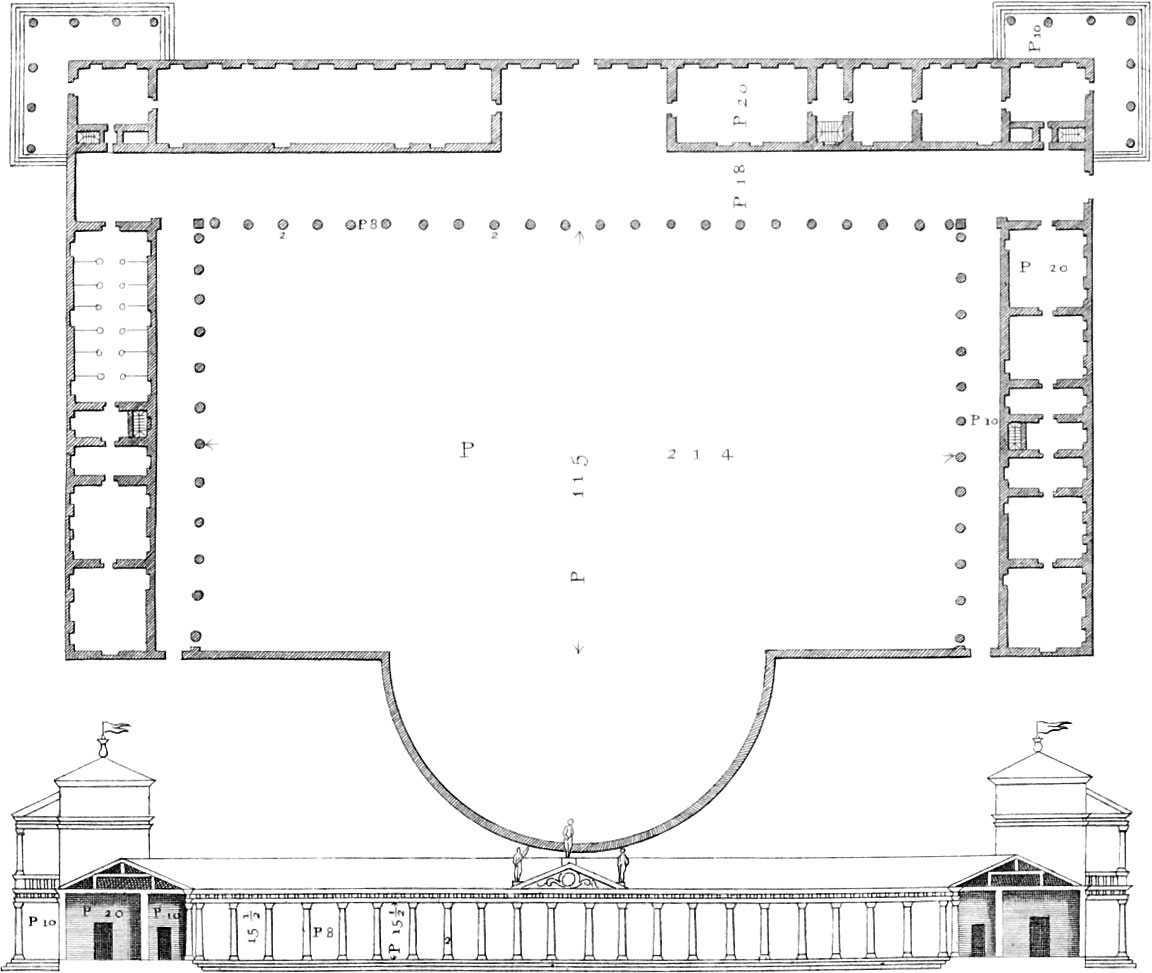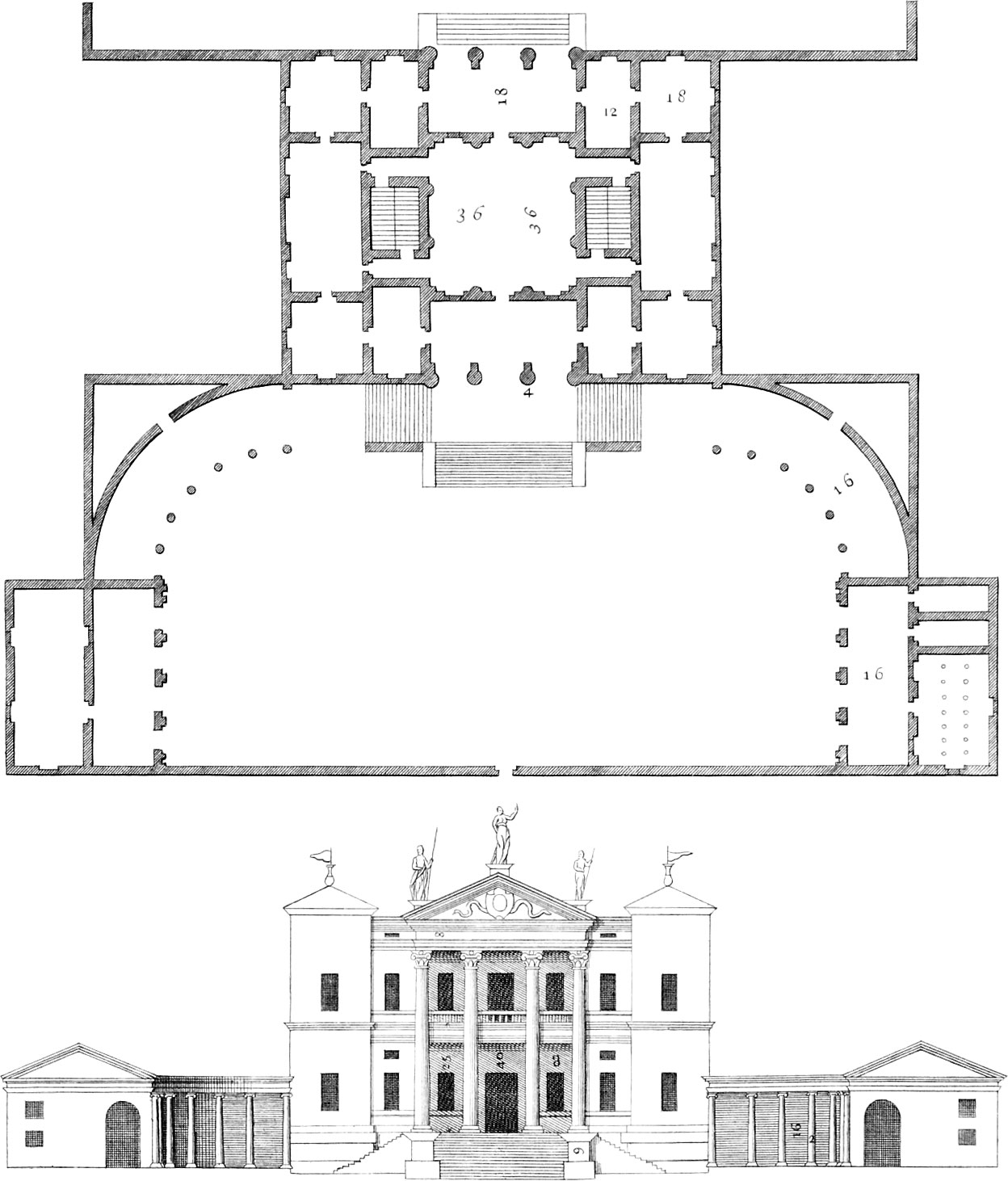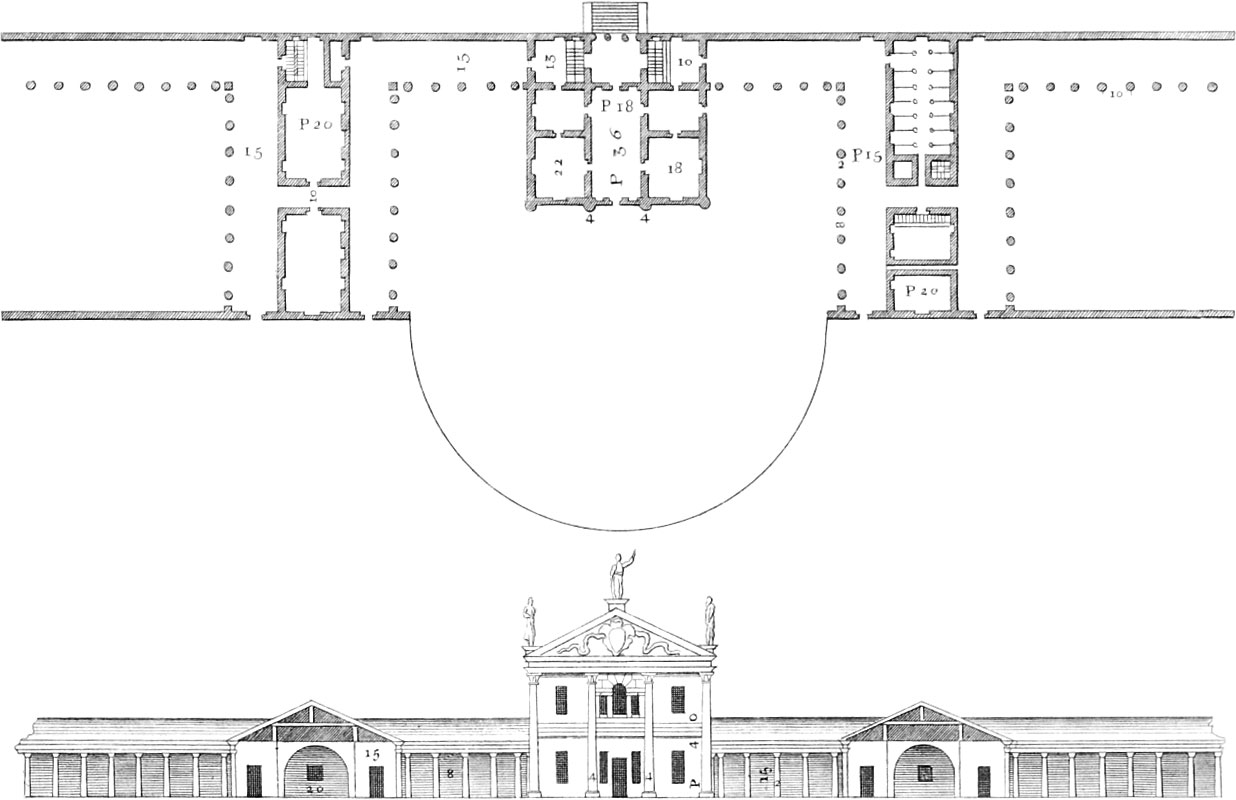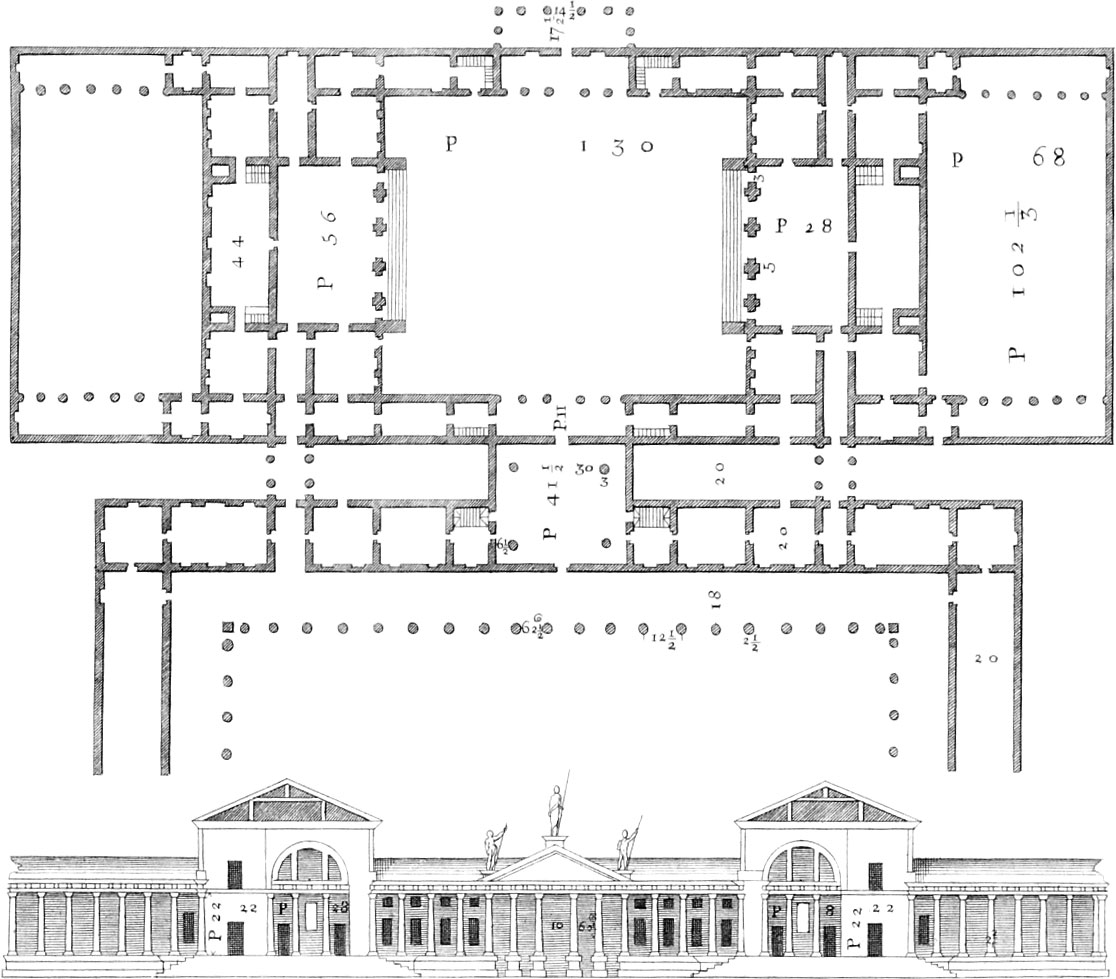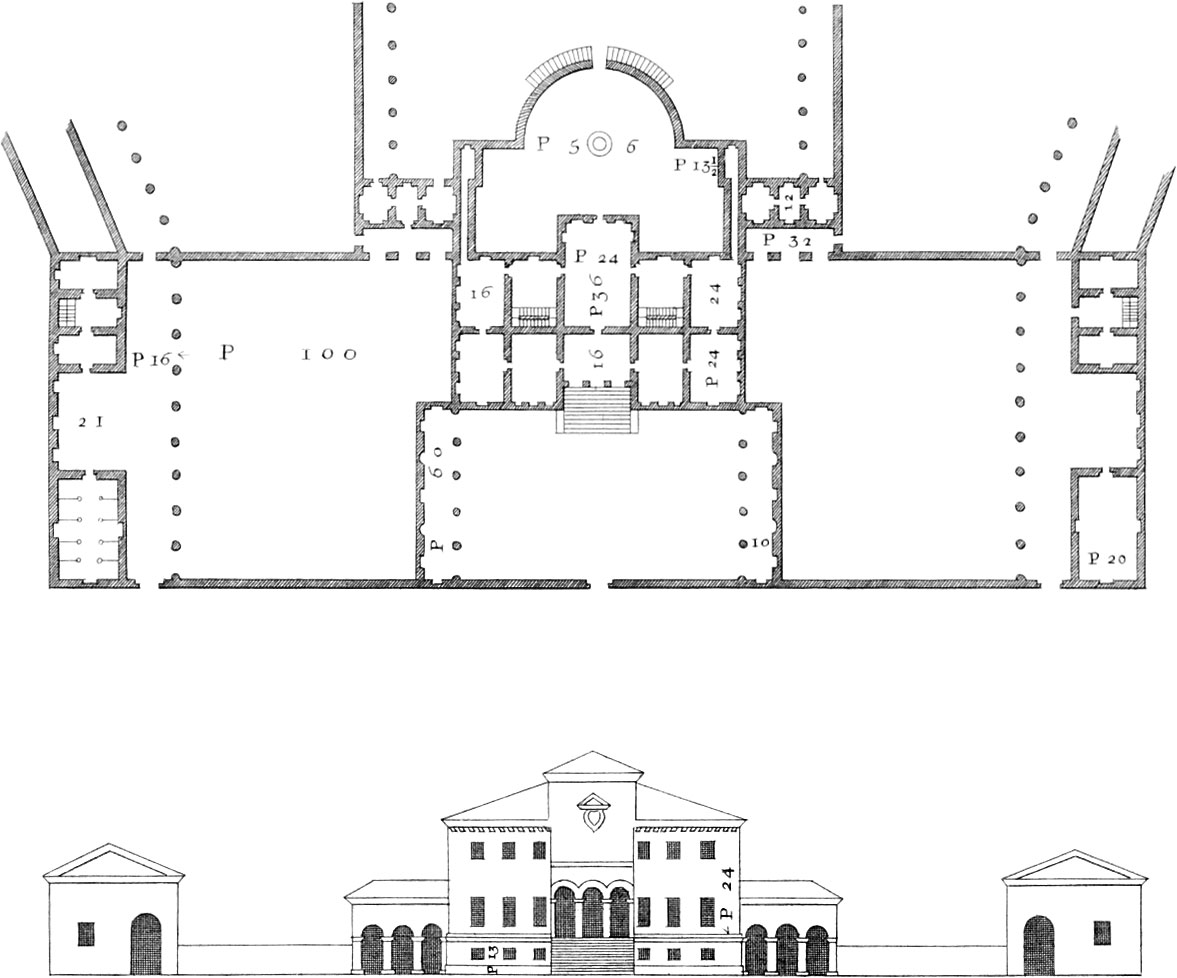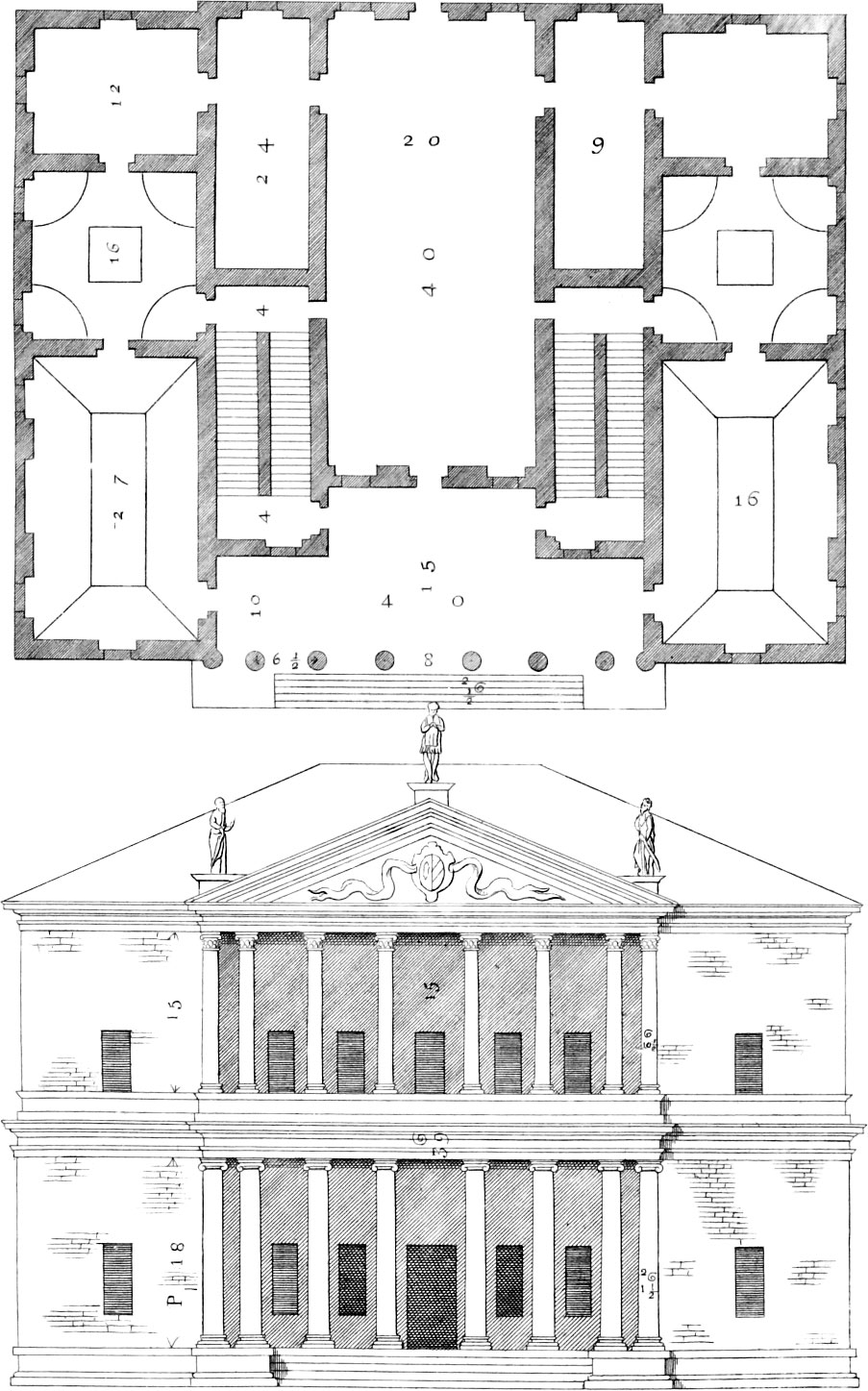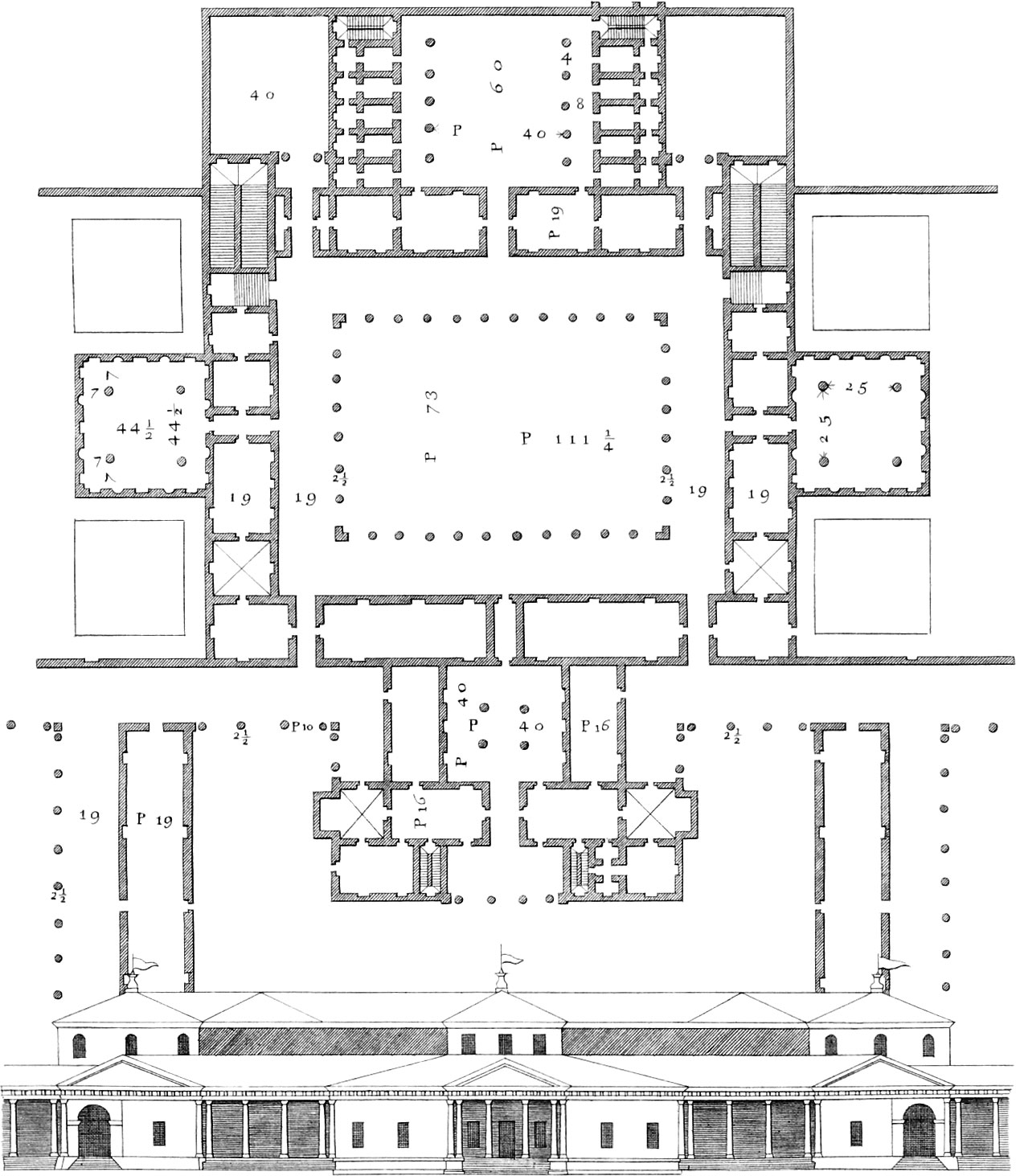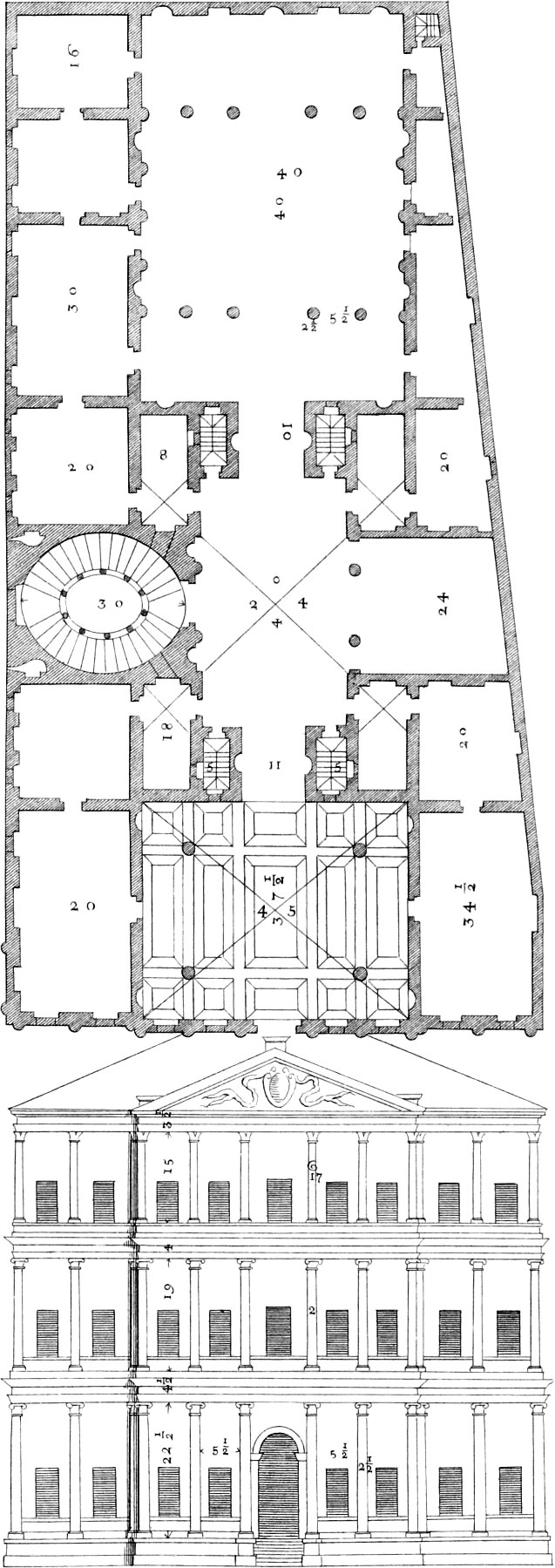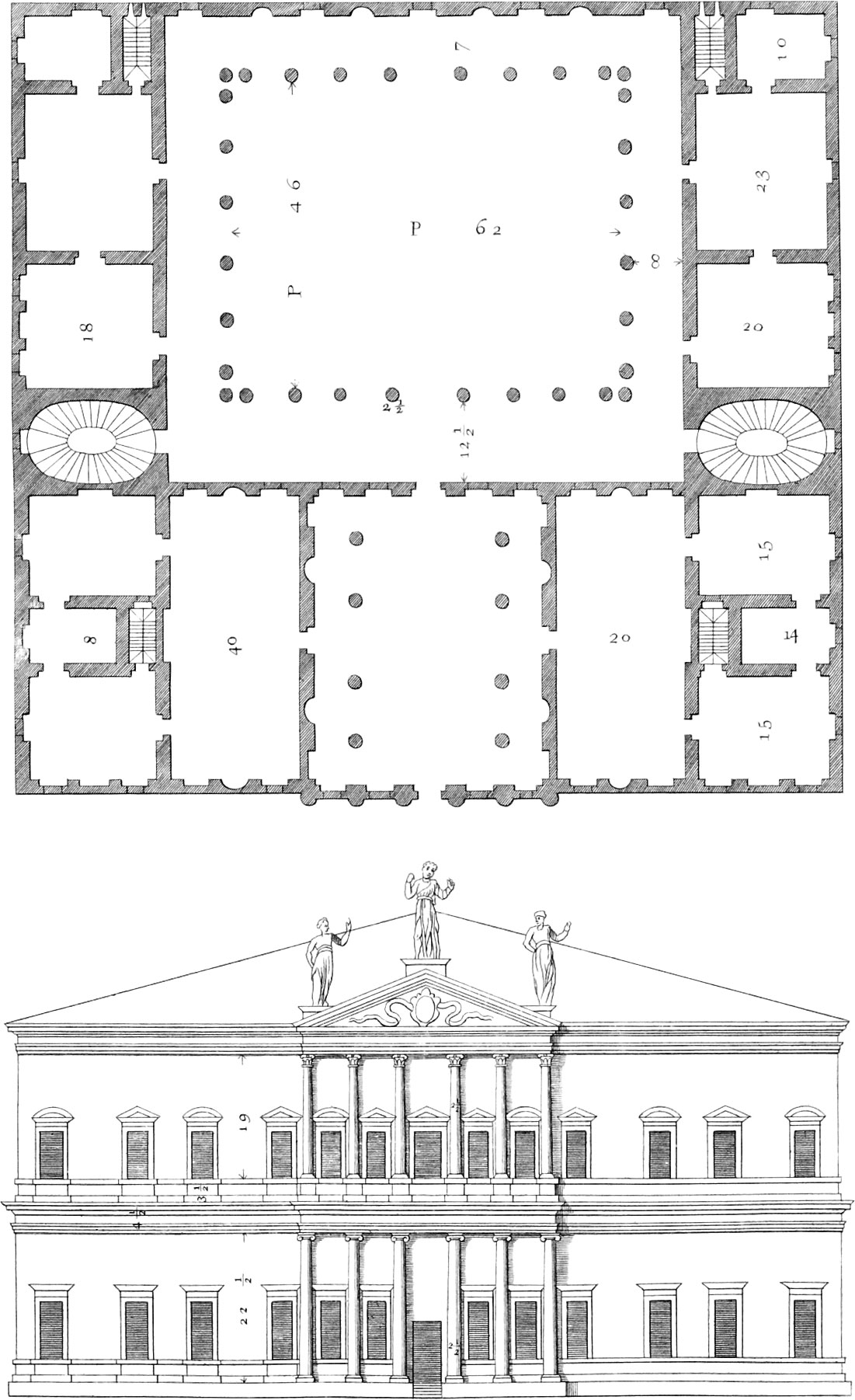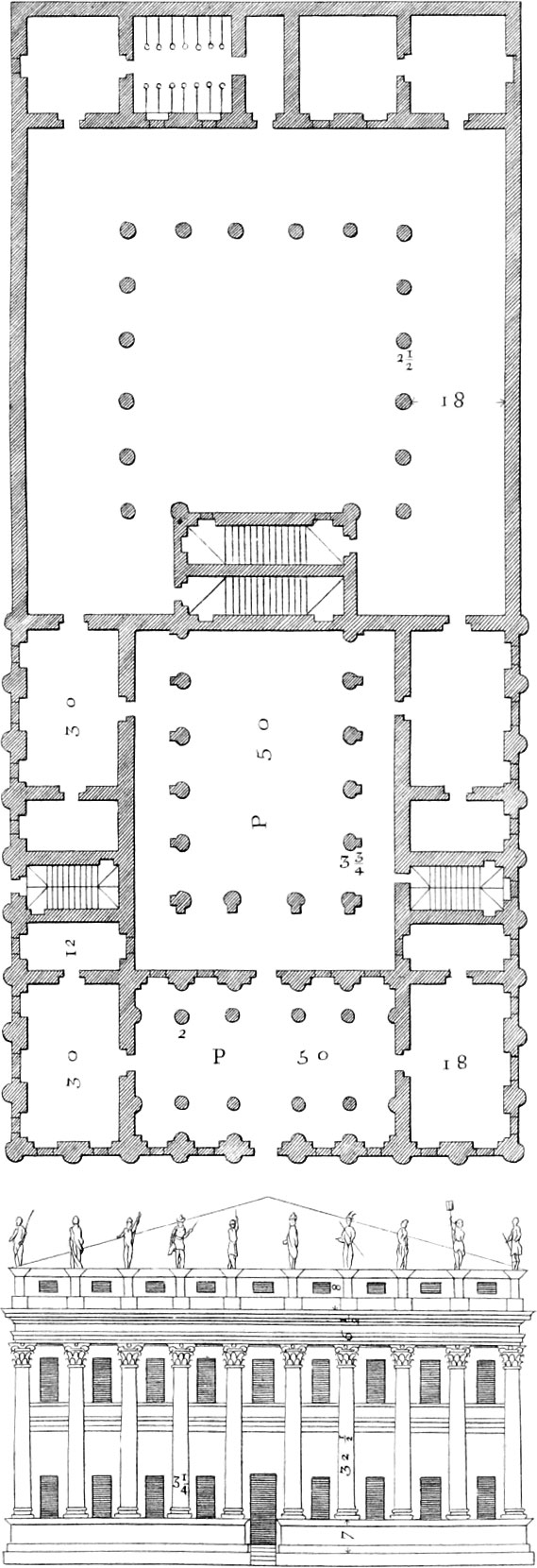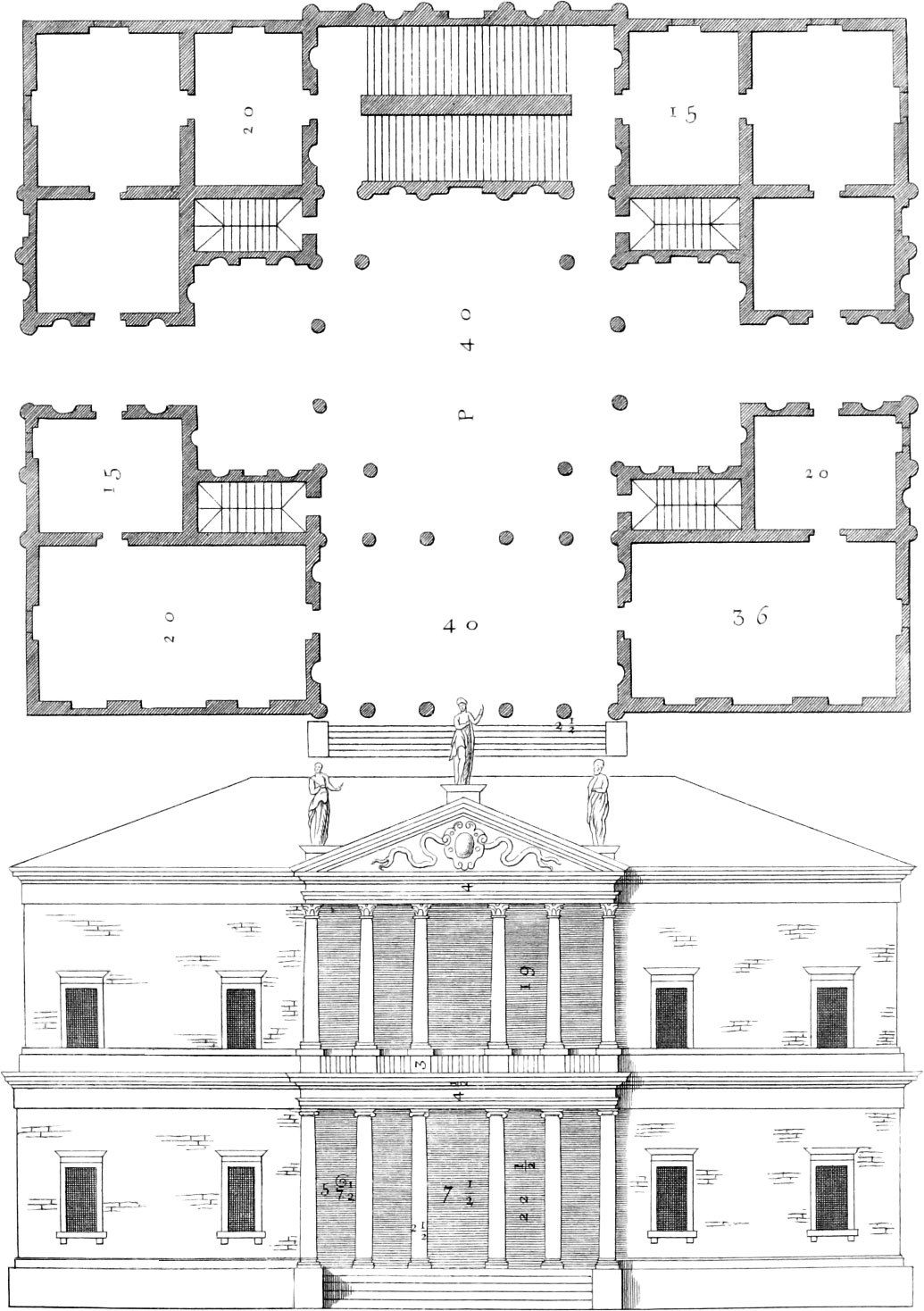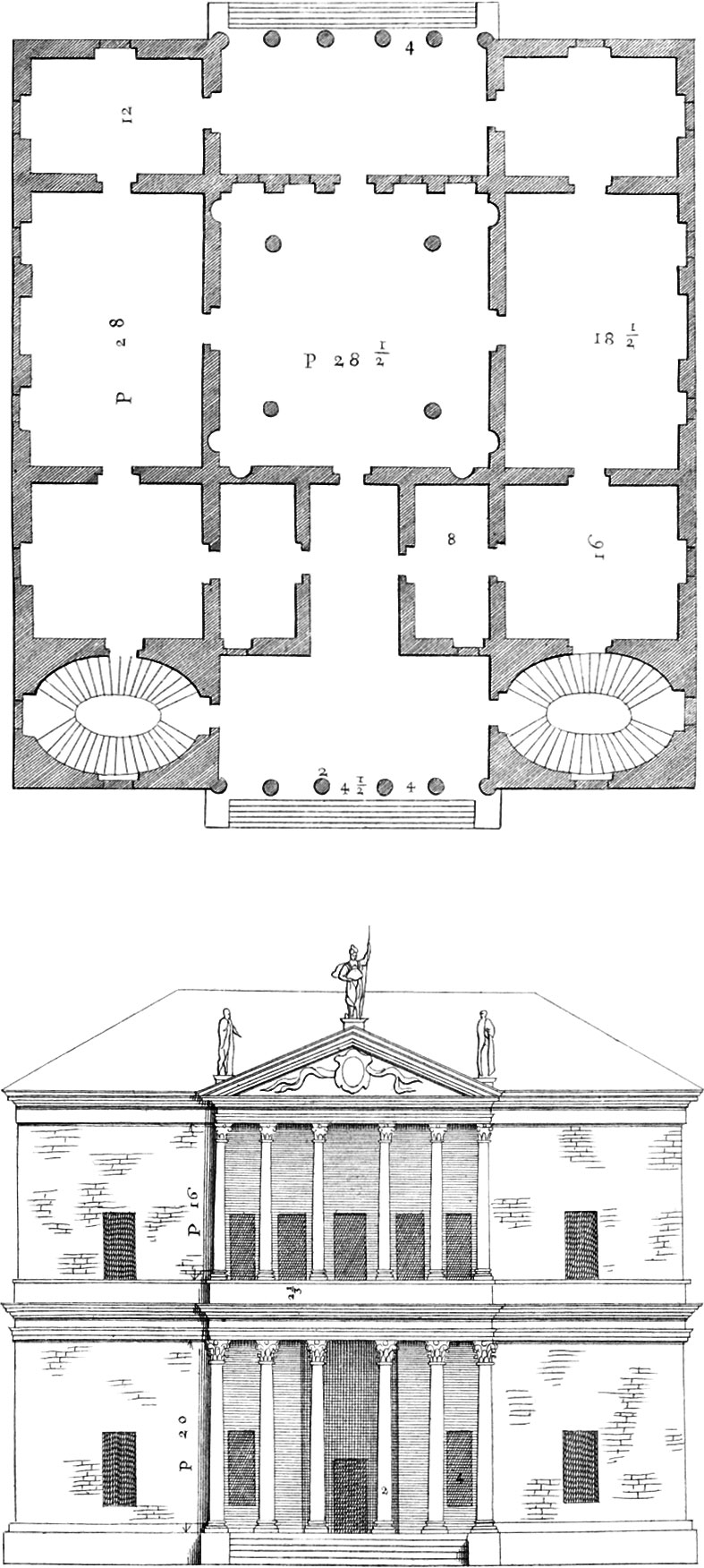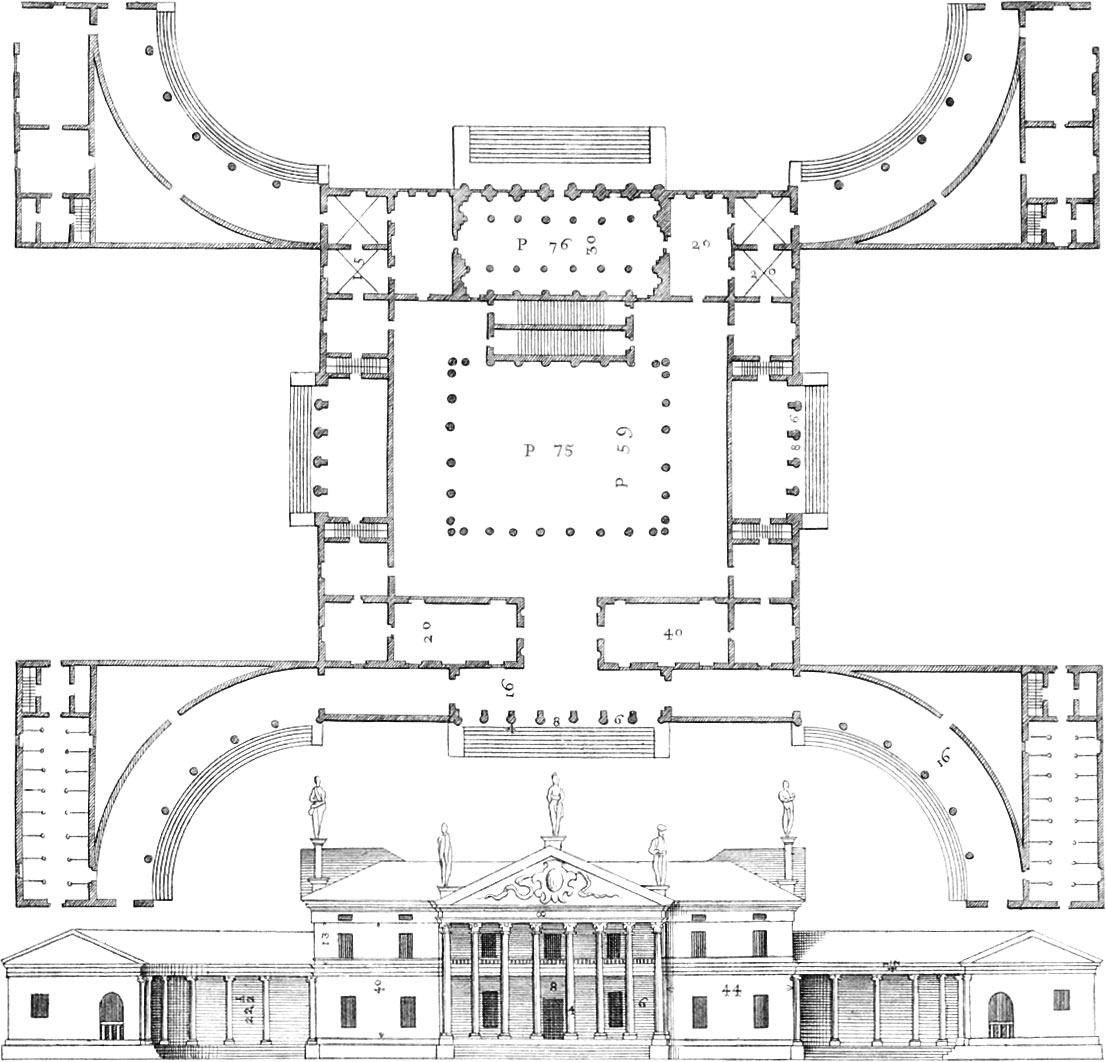Book II Italian, Greek & Latin Houses
Chapter I Of the decorum or conveniency that ought to be observed in private fabrics
I have explained in the foregoing book all those things, that to me seemed most worthy of consideration for the building of public edifices, and private houses, that the work might be beautiful, graceful and durable: I have there also mentioned some things belonging to the conveniency of private houses, to which this other book shall chiefly be applied: for that house only ought to be called convenient, which is suitable to the quality of him that is to dwell in it, and whose parts correspond to the whole and to each other.
But the architect ought above all to observe, that (Vitruvius says in the first and sixth book) for great men, and particularly those in a republic, the houses are required with loggias and spacious halls adorned, that in such places those may be amused with pleasure, who shall wait for the master to salute, or ask him some favour: and for gentlemen of a meaner station, the fabrics ought also to be less, of less expense, and have fewer ornaments. For judges and advocates, they ought likewise to be so built, that in their houses there may be handsome and well adorned places to talk in, that their clients may remain there without inconvenience.
Merchants houses ought to have places facing the north, where their merchandizes may be lodged; and to be so disposed, that the master may not be in fear of thieves.
Decorum is also to be observed in regard to the work, if the parts so answer to the whole, as that in great edifices there may be great members, in the little, small, and middling in the middle-sized: for what a disagreeable and unseemly thing would it be, if in a very large fabric there should be small halls and rooms; and, on the contrary, in a little one, there should be two or three rooms that took up the whole.
As much as possible, one ought therefore, as has been said, to have a regard to those who are inclined to build; and not so much to mind what they can afford to lay out as the quality of the building that is proper for them: when that is settled, the parts are to be so disposed, that they may be suitable to the whole, and to each other, and such ornaments are to be applied as shall seem most proper. But an architect is very often obliged, to conform more to the will of those who are at the expense, than to that which ought to be observed.
Chapter II Of the compartment or disposition of rooms, and of other places
That the houses may be commodious for the use of the family, without which they would be greatly blame-worthy, far from being commendable, great care ought to be taken, not only in the principal parts, as the loggia, halls, courts, magnificent rooms, and ample stairs, light and easy of ascent; but also, that the most minute and least beautiful parts be accommodated to the service of the greatest and more worthy: for as in the human boy there are some noble and beautiful parts, and some rather ignoble and disagreeable, and yet we see that those stand in very great need of these, and without them they could not subsist; so in fabrics, there ought to be some parts considerable and honoured, and some less elegant; without which the other could not remain free, and so consequently would lose part of their dignity and beauty. But as our Blessed Creator has ordered these out members in such a manner, that the most beautiful are in places most exposed to view, and the less comely in places the most seen, and the less beautiful, in places much hidden from the eye as possible; that in them may be lodged all the foulness of the house, and all those things that may give any obstruction, and in any measure render the more beautiful parts disagreeable. I approve therefore that in the lowest part of the fabric, which I made somewhat underground, may be disposed to the cellars, the magazines for wood, pantries, kitchens, servants-halls, wash-houses, ovens, and such like things necessary for daily use. From which disposition follow two conveniences, the one, that the upper part remains all free; and the other and no less important, is, that the said upper apartments are wholesomer to live in, the floor be looked at, and to look out of. It is also to be observed, that in the remaining part of the fabric there may be great, middle-sized, and small rooms, and all near one another, that they may reciprocally be made use of.
The small rooms may be divided off, to make closets where studies or libraries may be placed, riding accoutrements and other lumber, which may be every day wanted, and which would not be so proper to be in rooms, where one either sleeps, eats, or where strangers are received.
What contributes also to conveniency is, that the rooms for summer be ample, spacious and turned to the north; and those for the winter to the south and west, and rather small than otherwise: because we seek the shades and winds in summer, and in winter the sun; besides small rooms are much more easily warmed than large.
But those which we would make use of in spring and autumn, must be turned to the east, and ought to look over greens and gardens. In this particular part, studies and libraries ought also to be; because the morning is the most proper time of all other to make use of them.
But the large rooms with the middling, and those with the small, ought to be so distributed, that, as I have elsewhere said, one part of the fabric may correspond with the other; and that so the body of the edifice, may have in itself a certain convenience in its members, that may render the whole beautiful and graceful.
But as most commonly in cities, either the neighbours walls, the streets, or public places, prescribe certain limits, which the architect cannot surpass, it is proper he should conform himself to the circumstances of the situation; to which, if I mistake not, the following plans and elevations will give a great insight, and which may also serve as an example of what has been said in the foregoing book.
Chapter III Of the designs of town-houses
I am convinced, that in the opinion of those, who shall see the following fabrics, and know how difficult it is to introduce a new custom, especially in building, of which profession every one is persuaded that he knows his part, I shall be esteemed very fortunate, to have found gentlemen of so noble and generous a disposition, and of such excellent judgement, as to have harkened to my reasons, and departed from that antiquated custom of building without grace of beauty at all; and, indeed, I cannot but very heartily thank God, as we ought in all our actions to do, for granting me such a share of his favour, as to have been able to put in practice many of those things, which I have learnt from my very great fatigues and voyages, and by my great study.
And although some of the designed fabrics are not entirely finished, yet may one by what is done comprehend what the whole will be when finished. I have prefixed to each the name of the builder, and the place where they are, that every one may, if he pleases, really see how they succeed.
And here the reader may take notice, that in placing the said designs, I have respect neither to the rank or dignity of the gentlemen to be mentioned; but I have inserted them where I thought most convenient: not but they are all very honourable.
Let us know to come to the fabrics, of which the following is in Udine the metropolis of Friuli, and was raised from the foundation by Signor Floriano Antonini, a gentleman of that city. The first order of the front is of rustic work, the columns of the front, of the entrance, and of the loggia backwards are of the Ionic order. The first rooms are vaulted; the greater have the height of the vaults according to the first method beforementioned, for the height of the vaults in places that are longer than they are broad. The rooms above have flat ceilings, and so much wider than those below, as the contraction or diminution of the walls, and the height of the ceilings, equal to their breadth. Over these are other rooms which may server for granaries. The height of the hall reaches to the roof. The kitchen is out of the house, but very commodious nevertheless. The necessary places are on the sides of the stairs, and although they are in the body of the fabric, they do not give any offensive smell; because they are placed in part remote from the sun, and have vents from the bottom of the pit all through the thickness of the wall, to the very summit of the house.

This line is half the Vicentine foot, with which the following fabrics have been measured.
The whole foot is divided into twelve inches, and each inch into four minutes.
In Vicenza upon the Piazza, which is vulgarly called the Isola, the Count Valerio Chiericato, an honourable gentleman of that city, has built according to the following invention.
This fabric has in the part below a loggia forwards, that takes in the whole front: the pavement of the first order rises above the ground five foot; which has been done not only to put the cellars and other places underneath, that belong to the conveniency of the house, which would not have succeeded if they had been made entirely underground, because the river is not far from it; but also that the order above might the better enjoy the beautiful situation forwards. The larger have rooms the height of their vaults, according to the first method for the height of vaults: the middle-sized are with groined vaults, and their vaults as high as those of the larger. The small rooms are also vaulted, and are divided off. All these vaults are adorned with most excellent compartments of stucco, by Messer Bartolomeo Ridolfi, a Veronese sculptor; and paintings by Messer Domenico Rizzo, and Messer Batista Venetiano, men singular in this profession. The hall is above in the middle of the front, and takes up the middle part of the loggia below. Its height is up to the roof; and because it projects forward a little, it has under the angles double columns. From one part to the other of this hall, there are two loggias, that is, on each side one; which have their soffites or ceilings adorned with very beautiful pictures, and afford a most agreeable sight. The first order of the front is Doric, and the second Ionic.
Here follows the design of part of the front in a large form.
The following designs are of the house of the Count Iseppo de Porti, a very noble family of the said city. This house fronts two public streets, and therefore has two entrances, which have four columns each, that support the vault, and render the place above it secure. The first rooms are vaulted. The height of those, that are on each side of the said entrances, is according to the last method for the height of vaults. The second rooms, that is, of the second order, are with flat ceilings: and thus the first, as well as the second of that part of the fabric, which has been done, are adorned with paintings, and most beautiful stuccos by the hands of the aforesaid excellent artists, and of Messer Paolo Veronese, a most excellent painter. The court encompassed with porticos, to which one goes from the said entrances by a passage, is to have columns six and thirty foot and an half high, that is, as high as the first and second order. Behind these columns there are pilasters one foot and three quarters broad, and one foot and two inches thick, which support the pavement of the loggia above. This court divides the whole house into two parts: that forwards is for the use of the master, and the women belonging to him; and that backward to lodge strangers in; whereby those of the house, and the strangers will remain free in every aspect: to which the ancients, and especially the Greeks, had a very great regard.
Besides which, this partition will also serve in case the descendants of the said gentleman, should choose to have their apartments separate.
I have placed the principal stairs under the portico, that they may answer to the middle of the court; and those who have a mind to go up, may as it were be compelled to see the most beautiful part of the fabric; and also, that being in the middle, they may serve on part as well as the other. The cellars and such-like places are underground. The stables are out of the square of the house, and have their entrance under the stairs. Of the designs in a large form, the first is part of the front, and the second of the part towards the court.
The following fabric is in Verona, and was begun by the Count Giovianni Battista della Torre, a gentleman of that city, who being overtaken by death, could not finish it; but there is a great part done. One goes into this house by the flanks, where the passages are ten feet wide; from which one comes into the courts, each fifty feet long; and from these into an open hall, which has four columns for the greater security of the vault above. From this hall one goes to the stairs, which are oval, and open in the middle. The said courts have corridors or balconies round them, level with the floor of the second rooms. The other stairs serve for the greater conveniency of the whole house. This compartment succeeds extremely well in this situation; which is long and narrow, and has the principal street towards one of the lesser fronts.
The following designs are of a fabric in Vicenza, of the Count Ottavio de Thieni: It belonged to Count Marc’ Antonio, who began it. This house is situated in the middle of the city, near the piazza, and therefore I have thought proper to dispose of that part towards the piazza into shops: because the architect is also to consider the advantage of the builder, when it can be done conveniently, and where the situation is sufficiently large. Every shop has over it a mezato for the use of the shop-keeper; and over them are the rooms for the master.
This house is insular, that is, encompassed by four streets. The principal entrance, or as one may say, the master-gate, has a loggia forwards, and fronts the most frequented street of the city. The city hall is to be above; which will project even with the loggia. There are two entrances in the wings, which have the columns in the middle, placed there not so much for ornament, as they are to render the part above it secure, and to make the height proportionable to the breadth. From these entrances one goes into the court encompassed all round with loggias of pilasters. In the first order they are Rustic, and in the second of the Composite order. In the angles, there are octangular rooms, that succeed well, as well with respect to their form, as for diverse uses to which they may be accommodated. The rooms of this fabric that are now finished, have been adorned with the most beautiful stuccos, by Messer Alessandro Vittoria, and Messer Bartolomeo Ridolfi; and with paintings, by Messer Anselmo Canera, and Messer Bernardino India of Verona, not inferior to any of the present age. The cellars, and such like places, are underground; because this fabric is in the highest part of the city, where there is no danger that water should prove any inconvenience.
Of the following deigns, in a larger form of the above inserted fabric; the first part is of the front; the second is of the part towards the court.
The Counts Valmarana, a very honourable gentlemen, for their own honour and conveniency, and the ornament of their native country, have built in the said city, according to the following designs: in which fabric there is no want of any ornaments that can be thought of, as stuccos and paintings. This house is divided into two parts by the middle part; about which there is a corridor, or balcony, which leads them from the fore-part to that which is backwards. The first rooms are vaulted; the second with flat ceilings, and they are as high as they are broad. The garden, which is before one comes to the stables, is much larger than it is marked; but it has been made so small because the leaf would not have contained the stables and all the other parts. Thus much as to this fabric, having in this, as well as in all the others, inserted the measure of each part.
The following design is of half the front.
Amongst many honourable Vicentine gentlemen, there is Monsignore Paolo Almerico, an ecclesiastic, and who was referendary to two supreme Pops, Pio the fourth and fifth, who for his merit, deserved to be made a Roman citizen with all his family. This gentleman after having travelled many years out of a desire of honour, all his relations being dead, came to his native country, and for his recreation retired to one of his country-houses upon a hill, less than a quarter of a mile distant from the city, where he has built according to the following invention: which I have not thought proper to place amongst the fabrics of villas because of the proximity it has with the city, whence it may be said to be in the very city. The site is as pleasant and as delightful as can be found; because it is upon a small hill, of very easy access, and is watered on the side by the Bacchiglione, a navigable river; and on one the other it is encompassed with most pleasant risings, which look like a very great theatre, and are all cultivated, and abound with the most excellent fruits, and most exquisite vines: and therefore, as it enjoys from every part most beautiful views, some of which are limited, some more extended, and others that terminate with the horizon; there are loggias made in all the four fronts; under the floor of which, and of the hall, are the rooms for the conveniency and use of the family. The hall is in the middle, is round, and receives its light from above. The small rooms are divided off. Over the great rooms (the vaults of which are according to the first method) there is a place to walk round the hall, fifteen foot and a half wide. In the extremity of the pedestals, that form a support to the stairs of the loggias, there are statues made by the hands of Messer Lorenzo Vicentino, a very excellent sculptor.
Signor Guilio Capra, likewise a most noble cavalier, and a Vicentine gentleman, for an ornament to his native country, rather than from any necessity he was under of so doing, has prepared the materials to build, and has begun according to the following designs, in a most beautiful site, in the principal street of the city. This house will have courts, loggias, halls and rooms; some of which will be great, some middling, and others small. This form will be beautiful, and diversified; and certainly that gentleman will have a very stately and magnificent house, suitable to his noble mind.
- an open court
- a court likewise uncovered
- the court
- the hall which in the lower part has columns, and free above, that is, without columns
I made the present invention for a site, belonging to the Count Montano Barbarano at Vicenza; in which, by reason of the situation, I did not observe the same order on one part, as I did on the other. Now this gentleman has brought the neighbouring piece of ground, and therefore the same order is observed in both parts; as in one part the stables are placed, and the lodgings for servants (as may be seen in the design) so in the other there are rooms that will serve for a kitchen, and places for women, and for other conveniences. They have already begun to build, and have raised the front according to the following design, in a large form. I have not yet inserted the design of the plan, according as it was finally concluded on, and according as the foundations are already laid, since I could not get it graved time enough to have it printed. The entrance of this invention has some columns which support the vault, for the reasons already mentioned. On the right and left there are two rooms one square and a half long; and after these, two square ones; and besides these, two closets. Opposite to the entrance there is a passage, from which one comes into a loggia over the court. This passage has a closet on each side, and over them mezatis, to which the principal stairs of the house serve. All the vaults of these places are one and twenty foot and a half high. The hall above, and all the other rooms, are with flat ceilings; the small rooms only have their vaults as high as the ceilings of the rooms. The columns of the front have pedestals under them, and support the balcony; into which one enters by the sofita. The front is not to be made in this manner (as was said) but according to the following design, in a large form.
Chapter IV Of the Tuscan Atrio, or porch
After having set down some of those fabrics I have directed in cities, it is very proper that, to keep my promise, I should insert the designs of some of the principal parts of the houses of the ancients. And because the Atrio was a very remarkable part of them, I shall first make mention of the Atrios, or porches, and then of the places adjoined to them, and so proceed to the halls.
Vitruvius says, in his sixth book, that there were five kinds of Atrios among the Ancients, that is, the Tuscan, of four columns; the Corinthian, Testuginato, and Uncovered, of which I do not intend to speak. The following designs are of the Tuscan Atrio. The breadth of this Atrio is two thirds the length. The breadth of the Tablino is two fifths of that of the Atrio, and of the same length. From this one passes into the Peristillio, that is, into the court with porticos round it; which is one third longer than it is broad. The porticos are as wide as the columns are long. On the sides of the Atrio small halls might be made, that would look over the gardens; and if they were made as one see sin the design, their columns would be of the Ionic order, twenty foot long, and the portico would be as wide as the intercolumniation. Above them there would be other columns, of the Corinthian order, one fourth part less than those below; between which there would be windows to receive light. Over the Anditi there should be no covering, but they should have balustrades round them; and according to the situation, they might be made either longer or shorted than when I have designed, according as it should be necessary for the use and conveniency of those who were to dwell there.
Here follows the design of this Atrio in a larger form.
- Atrio
- Frize, or beam of limitation
- the door of the Tablino
- Tablino
- Portico of the Peristillio
- Loggia before the Atrio, which we may call Vestibulo
Chapter V Of the Atrio with four columns
The following design is of the Atrio with for columns; with is in breadth three parts of five of its length. The columns are Corinthian; their diameter is half the breadth of the wings. The uncovered part is a third part of the breadth of the Atrio, and as long. From the Atrio through the Tablino one passes into the Peristilio; which is in length one square and a half. The columns of the first order are Doric, and the porticos are as broad as the said columns are long. Those above, that is, of the second order, are Ionic, for fourth part less than those of the first, under which there is a Poggio, or pedestal, two foot and three quarters high.
- Atrio
- Tablino
- door of the Tablino
- portico of the Peristilio
- rooms near the Atrio
- Loggia through which one enters the Atrio
- the uncovered part of the Atrio, with balustrades round it
- the wings of the Atrio
- frieze of the cornice of the Atrio
- solid part over the columns
- measure of ten feet
Chapter VI Of the Corinthian Atrio
The following fabric is of the convent de la Carita where are regular canons at Venice. I have endeavoured to make this house like those of the ancients; and therefore I have made a Corinthian Atrio to it, whose length is the diagonal line of the square of its breadth. The wings are one part of three and a half, or two sevenths of its length. The columns are of the Composite order, three foot and a half thick, and five and thirty foot long. The uncovered part in the middle is the third part of the breadth of the Atrio. Over the columns there is an uncovered terrace level with the floors of the third order of the cloister where the Friar’s cells are. The scarcity is on one side near the Atrio, encompassed with a Doric cornice, which supports the vaults. The columns there seen, support that part of the wall in the cloister, which in the part above, divides the chambers or cells from the loggias. This sacristy serves for a tablino (so they called the place where they lodged the images of their ancestors) though for the conveniency, I have placed it on one side of the Atrio. On the other side is the place for the chapter, which answers to the sacristy. In the part near the church there is an oval staircase, void in the middle, which is very convenient and pleasant. From the Atrio one enters into the cloister, which has three orders of columns, one over the other. The first is Doric, and the columns project from the pilasters more than one half. The second is Ionic; the columns are one fifth part less than those of the first. The third is Corinthian, and the columns are a fifth part less than those of the second. In this order, instead of pilasters, there is the continued wall; and directly over the arches of the inferior orders, there are windows which give light to the entrance into the cells, the vaults of which are made with reeds, that they may not overcharge the walls. Opposite to the Atrio and cloister, beyond the stairs, one finds the rectory, which is two squares long, and as high as the floor of the third order of the cloister: It has a loggia on each side, and underneath a cellar made in the same manner as cisterns are, that the water may not get in. At one end it has the kitchen, ovens, a yard for poultry, a place for wood, a place to wash clothes in, and a very agreeable garden; and at the other end, other kind of places.
There are in this fabric, besides places for strangers, and others that server for different purposes, forty four rooms, and forty six cells.
Of the designs that follow, the first is part of this Atrio in a larger form, and the second part of the cloister.
Chapter VII Of the Atrio Testugginato, and of the private houses of the ancient Romans
Besides the abovesaid different manners of Atrios, there was another very much in use among the ancients, by them called Testugginato: and because this part is very difficult, from the obscurity of Vitruvius, and worthy of a particular regard, I shall mention what I think of it, adjoining thereto the disposition of the Oeci, or small halls, Cancellarie, Tinelli, baths, and other places; so that in the following design there will be all the parts of the private house set in their proper places according to Vitruvius. The Atrio is as long as the diagonal of the square of the breadth, and as high as it is broad, up to the limitary beam. The rooms on the side thereof, are six foot less in height; and upon the walls, which divide them from the Atrio, there are some pilasters that support the Testudine, or covering of the Atrio; and through the distances between them it receives light; and the rooms have an open terrace over them. Opposite to the entrance is the Tablino, which is one part of two and a half, or two fifths of the breadth of the Atrio; and those places served, as I before said, to place the images and statues of their ancestors in. Farther on, is the Peristilio, which has porticos round it, and broad as the columns are long. The rooms are of the same breadth, and are as high to the impost of the vaults as they are broad, and the vaults are in height of a third of the breadth.
Several sorts of Oeci are described by Vitruvius (it was these halls, or Salotte, in which they made their festivals and entertainments, and where the women worked) that is, Tetrastili; so called, because there were four columns; the Corinthian, which had semi-columns round them; the Egyptian, which over the first columns were enclosed with a wall with semi-columns directly over the first, and one fourth part less. In the inter-columniations there were windows, from which the part in the middle received light. The height of the loggias that were round them, did not pass the first columns, and over that it was uncovered, and encompassed with a corridor or balcony. The designs of each of these shall be separately set down. The square Oeci were places to be in the cool in the summer: and looked upon gardens and other green places. There were also other Oeci made, which they called Ciziceni, which also proved for the conveniencies abovesaid. The Cancellarie, and libraries were in proper places towards the east; and also the Ticlini, which were places where they did eat. There were also baths for the men and women, which I have designed in the farthest part of the house.
- Atrio
- Tablino
- Peristilio
- Corinithian Salotti
- Salotti with four columns
- Basilica
- places for summer
- rooms
- library
- Atrio
- windows which give light to the Atrio
- door of the Tablino
- Tablino
- Portico of the Cortile
- Loggia before the Atrio
- Cortile
- rooms round the Atrio
- Loggia
- beam of limitation, or frieze of the Atrio
- part of the Corinthian hall
- uncovered place, over which the light comes into the Atrio
Chapter VIII Of the Halls with four columns
The following design is of the halls, which were called Tetrastili, because they had four columns. These were made square; and the columns were put to make the breadth proportionable to the height, and to make the place above secure; which I have done myself in many fabrics, as has been seen in the foregoing designs, and will be in those that follow.
Chapter IX Of the Corinthian Halls
The Corinthian halls were made in two manners, that is, either with columns which rose from the ground, as may be seen in the first design; or with columns upon pedestals, as they are in the second: But in the one as well as the other, the columns were made close to the wall; and the architraves, friezes and cornices were wrought with stucco, or made of wood, and there was but one order of columns. The vault was made either of a semi-circle, or a Schiffo, that is, it had as much height, as was the third part of the breadth of the hall, and ought to be adorned with compartments of stucco and paintings. The length of these halls would be very beautiful of one square and two thirds the breadth.
Chapter X Of Egyptian Halls
The following design is of the Egyptian halls, which resembled Basilicas very much, (that is, places where justice was administered) of which mention shall be made when we treat of the piazzas: because in these halls there was a portico commonly made with the columns at a distance from the wall, as they are in the Basilicas; and over the columns there were the architraves, the friezes, and the cornices. The space between the columns and the wall was covered with pavement. This pavement was uncovered, and formed a Corridor, or balcony, round. Above the said columns there was a continued wall, with semi-columns on the inside, one fourth part less than the abovesaid; and between the inter-columniations there were windows, which gave light to the hall, and through which, from the said uncovered pavement, one might see into it. These halls must needs have been of an admirable magnificence, as well by reason of the ornament of the columns, as also for its height; because the soffit lay over the cornice of the second order, and must have been very commodious when festivals and entertainments were made there.
Chapter XI Of Private Houses of the Greeks
The Greeks held a different manner of building from the Latins; because, as Vitruvius says, omitting the loggias and atrios, they made the entrance of the house little and narrow; and on one part placed the stables for horses, and on the other the porters rooms. From this first passage one entered the court; which had on three sides porticos, and on the part fronting the south they made two Anti, i.e. pilasters, which supported the beams of the more inward ceilings; because some space being left on one side, and the other, there were very large places appointed for the mothers of families, wherein they dwell with their men and women servants. And even with the said Anti were some rooms, which we may call antichamber, chamber, and back room, as they are one behind the other. Round the porticos were places for eating, sleeping, and for other like necessary things to the family. To this edifice they annexed another, of much greater size, and ornament, with more ample courts; in which they either made four porticos of an equal height, or one that was greater, viz. that which fronted the south, and the court which had this higher portico was called Rhodiaco; perhaps because the invention came from the Rhodians. These courts had magnificent loggias forwards, with particular gates of their own, wherein the men only dwelt. Near this fabric, on the right and left, they made other houses, which had particular gates of their own, and all the conveniences necessary to make them habitable; and in these strangers were lodged: for it was the custom among these people, when a stranger came, to conduct him the first day to eat with him, and then to assign him a lodging in the said houses, and send him thither all the necessities of life; whereby the strangers were in every respect as free, as if they had been in their own house.
Let it suffice to have said thus much concerning the houses of the Greeks, and of city houses.
Of the parts of the houses of the Greeks.
- passage
- stables
- places for the porters
- first court
- entrance to the rooms
- places where the women did their work
- first great room, which we shall call the antichamber
- middling chamber
- small room
- small halls to eat in
- the rooms
- second court, larger than the first
- portico greater than the three others, from which the court is called Rhodiaco
- place leading from the lesser into the greater court
- the three porticos, having small columns
- Triclini, Ciziceni, and Cancelarie, or the places to be painted
- hall
- library
- square halls, where they used to eat
- the houses for the strangers
- little alleys, which parted the said houses from those of the master
- small uncovered courts
- principal street
Chapter XII Of the Site to be chosen for the fabrics of Villas
The city houses are certainly of great splendour and conveniency to a gentleman who is to reside in them all the time he shall require for the administration of the republic, or for directing his own affairs. But perhaps he will not reap much less utility and consolation from the country house; where the remaining part of the time will be passed in seeing and adorning his own possessions, and by industry, and the art of agriculture, improving his estate; where also by the exercise which in a villa is commonly taken, on foot and on horseback, the body will the more easily preserve its strength and health; and, finally, where the mind, fatigued by the agitations of the city, will be greatly restored and comforted, and be able quietly to attend the studies of letters, and contemplation.
Hence it was the ancient sages commonly used to retire to such like places; where being oftentimes visited by their virtuous friends and relations, having houses, gardens, fountains, and such like pleasant places, and above all, their virtue, they could easily attain to as much happiness as can be attained here below.
Having now, by the help of God, gone through what I had to say concerning city houses; it is just that we proceed to those of the country, in which private and family affairs are chiefly transacted.
But before we come to the designs of these, it seems not improper to say something concerning the situation or place to be chosen for those fabrics, and of their disposition; because, as we are not confined (as commonly happens in cities) by public walls, or those of our neighbours, to certain and determinate bounds, it is the business of a wise architect, with the utmost care and diligence, to seek and find out a convenient and healthy place: since we are, for the most part, in the country during the summer season; at which time, even in the most healthy places, our bodies become weak and sickly, by reason of the heat.
In the first place therefore, let a place be chosen as convenient as possible, and in the middle of the estate, that the owner, without much trouble, may view and improve it on every side, and that the fruits thereof may be the more conveniently carried by the labourers to his house.
If one may build upon a river, it will be both convenient and beautiful; because at all times, and with little expense, the products may be conveyed to the city in boats, and will serve for the uses of the house and cattle. Besides the cooling the air in summer very much, it will afford a beautiful prospect, with which the estates, pleasure and kitchen gardens may with great utility and ornament be watered, which are the sole and chief recreation of a villa.
But if navigable rivers cannot be hat, one must endeavour to build near some other running water; and above all to get at a distance from standing waters, because they generate a very bad air: which we may very easily avoid, if we build upon elevated and cheerful places, where the air is, by the continual blowing of the winds, moved; and the earth, by its declivity, purged of all ill vapours and moisture: and where the inhabitants are healthy and cheerful, and preserve a good colour, and are not molested by gnats and other small animals, which are generated by the putrefaction of still fenny waters.
And because the waters are very necessary to human life, and according to their various qualities they produce in us different effects; some generating the spleen, others glandulous swellings in the neck, others the stone, and many other diseases:
Great care ought to therefore be taken, not to build near those waters which have any odd taste, or which partake of any colour; but be clear, limpid, and subtile, and which, being sprinkled upon a white cloth, do not stain it: because these will be certain signs of their goodness.
There are many methods to find whether the waters are good, taught us by Vitruvius: but that water is deemed perfect which makes good bread, and in which greens are quickly boiled; and which, being boiled, does not leave any fur or sediment at bottom of the vessel.
It will be an excellent sign of the goodness of the water, if, where it passes, one does not see moss or rushes grow; but the place is clean, beautiful, and has sand or gravel at the bottom, and is not foul and muddy.
The animals which are accustomed to drink of them, will also be an indication of the goodness and salubrity of the waters, if they are lively, robust, and fat, and no weak and lean.
But with regard to the wholesomeness of the air, besides the aforesaid particulars, the ancient edifices will give an indication thereof, if they are not corroded and spoiled: if the trees are well nourished and beautiful, and not bent in any part by the winds, and if they are not such as grow in fenny places.
And if the stones produced in those places do not appear on the surface to be putrified; and also if the colour of the inhabitants be natural, and shows a good temperature.
One ought not to build in valleys enclosed between mountains; because edifices in valleys are there hit, and are deprived of feeling at a distance, and of being seen. These are without dignity and grandure, and also entirely contrary to health; because the earth being impregnated by the rains that settle there, sends forth pestiferous vapours, infecting both the body and mind; the spirits being by them weakened, the joints and nerves emasculated: and what is lodged in the granaries will corrupt through the too great moisture.
Besides which, if the sun happens to shine, the reflection of its rays will cause excessive heats; and if it doth not, the continual shade will render the people in a manner stupid and discoloured.
And when the winds enter into the said valleys, it will be with too much fury, as if it were through narrow channels; and when they do not blow, the collected air will grow gross and unhealthy.
When there is a necessity of building upon a mountain, let a situation be chosen facing a temperate part of the heaven, and which is not by higher mountains continually shaded, nor scorched (as it were by two suns) by the sun’s reverberation from some neighbouring rock; for in either of these cases it will be exceeding bad to dwell in.
And, finally, in the choice of the situation for the building a villa, all those considerations ought to be had, which are necessary in a city house; since the city is as it were a great house, and, on the contrary, a country house is a little city.
Chapter XIII Of the compartment or disposition of the Villas
The agreeable, pleasant, commodious, and healthy situation being found, attention is to be given to its elegant and convenient disposition. There are two sorts of fabrics required in a villa: one for the habitation of the master, and his family; and the other two manage and take care of the produce and animals of the villa. Therefore the compartment of the site ought to be in such a manner, that the one may not be any impediment to the other.
The habitation for the master ought to be made with a just regard to his family and condition, and as has been observed in cities, of which mention has been made.
The covertures for the things belonging to a villa, must be made suitable to the estate and number of animals; and in such manner joined to the master’s habitation, that he may be able to go to every place under cover, that neither the rains, nor the scorching fun of the summer, may be a nuisance to him, when he goes to look after his affairs; which will also be great use to lay wood in under cover, and an infinite number of things belonging to a villa, that would otherwise be spoiled by the rains and the sun: besides which these porticos will be a great ornament.
Regards must be had in lodging the men employed for the use of the villa, the animals, the products, and the instruments, conveniently, and without any constraint. The rooms for the steward, for the bailiff or farmer, and for the labourers, ought to be in a convenient near to the gates, for the safeguard of all the other parts.
The stables for the working animals, such as oxen and horses, must be at a distance from the master’s habitations, that the dunghills may be at a distance from it, and be placed in very light and warm places.
The places for breeding animals, as hogs, sheep, pigeons, fowls, and such like, are to be disposed according to their quality and nature: and in this the custom of different countries ought to be observed.
The cellars ought to be underground, enclosed, and far from any noise, moisture, or ill smell, and ought to receive their light from the east, or from the north; because that having it from the other part, where the sun might heat them, the wines being thereby warmed would grow weak, and be spoiled. They must be made somewhat sloping in the middle, and have their floors of terazzo, or paved in such a manner, that should the wine happen to run out, it may be taken up again. The tubs in which the wine is fermented must be placed under the covertures that are made near the said cellars, and so raised, that their outlets may be something higher than the bung-holes of the barrels, that the wine may be the more easily conveyed, either through leather pipes or wooden channels, from the said tubs into the barrels.
The granaries ought to have their light towards the north, because the corn cannot so easily be heated, but rather cooled by the winds; and thereby it will be a long time preserved, and none of those little animals will bread there, which damage it very much. Their floor, or pavement, ought to be of terrazzato, if it can be had, or at least of boards; because the corn will be spoiled by touching of lime.
The other store-rooms ought also, for the said reasons, to look towards the same part of heaven.
Hay-lofts ought to face the south or west; because the hay being dried by the heat of the sun, it will not be in danger of corrupting and taking fire. The instruments necessary to the husband-men, must be in convenient places under cover towards the south. The grange, where the corn is threshed, ought to be exposed to the sun, ample, spacious, paved, and a little raised in the middle, with porticos round it, or at least on one side; that in case of sudden rains, the corn may be immediately conveyed under cover; and must not be too near the masters house, by reason of the dust, nor so far off as to be out of sight.
This in general will suffice concerning the election of sites, and their compartments. It remains (as I have promised) that I insert the designs of some of the fabrics which I have directed in the country, according to several inventions.
Chapter XIV Of the Designs of the country-houses belonging to some noble Venetians
The following fabric is at Bagnolo, a place two miles distant from Lonigo, a castle in the Vicentine, and belongs to the magnificent Counts Vittore, Marco, and Daniele de Pisani, brothers. The stables, the cellars, the granaries, and such like other places, for the use of the villa, are on each side of the court. The columns of the porticos are of the Doric order. The middle part of this fabric is for the master’s habitation. The pavement of the first rooms, are seven foot high from the ground; under which are the kitchen and such like places for the family. The hall is vaulted, in height once and half its breath. To this height also joins the vault of the loggias. The rooms are with flat ceilings, and their height equal to their breadth; the length of the greater is one square and two thirds, and of the others one square and an half. And it is to be observed, that great attention has not been given, in putting the lesser stairs in a place where they might have a strong light, (as we have recommended in the first book) because they being to serve to places below, and to those above, which are for granaries and mezzati; wherefore, regard has been chiefly had to accommodate well the middle order, which is for the master’s habitation, and for strangers. The stairs that lead to this order, are put in a very proper places, as may have be seen by the designs.
The following fabric belongs to the magnificent Signor Francesco Badoero, in the Polesine, at a place called La Frata, on a site somewhat elevated, and washed by a branch of the Adige, where formerly stood a castle, belonging to Salinguerra de Este, brother-in-law to Ezzelino da Romano.
The base to the whole edifice is a pedestal, five feet high; the pavement of the rooms is level with this height, which are all with flat ceilings, and have been adorned with grotesque work of a beautiful invention, by Giallo Fiorentino. The granaries are above, and the kitchen, cellars, and other places belonging to its convenience, are below. The columns of the loggias of the master’s house, are of the Ionic order. The cornice, like a crown, encompasses the whole house. The frontispiece, over the loggias, forms a beautiful sight, because it makes the middle part higher than the sides. Lower on the plane are found the places for the steward, bailiff or farmer, stables, and other suitables for a villa.
The magnificent Signor Marco Zeno has built according to the following invention at Cesalto, a place near the Motta, a castle in the Trevigiano. The pavement of the rooms, all which are vaulted, is level with a basement which encompasses the whole fabric. The height of the vaults of the greater, is according to the second manner for the height of vaults. Those that are square, have lunetti in the angles over the windows. The little rooms next to the loggia, are coved à fascia, as also the hall. The vault of the loggia is as high as that of the hall, and both exceed the height of the rooms. This fabric has gardens, a court, a dove house, and all that is necessary for a villa.
Not very far from the Gambarare, on the Brenta, is the following fabric, belonging to the magnificent Signors Nicolo’ and Luigi de Foscari. This fabric is raised eleven foot from the ground; and underneath are the kitchens, servants halls, and such like places, and vaulted above as well as below. The height of the vaults of the greater rooms, is according to the first manner for the height of the vaults. The square rooms have their vaults à cupola. Over the small rooms, there are mezzati. The vaults of the hall is crossed semicircularly: the height of its impost, is as high as the hall is broad; which has been adorned with most excellent paintings, by Messer Battista Venetiano. Messer Battista Franco, a very great designer of our times, had begun to paint one of the great rooms; but being overtaken by death, has left the work imperfect. The loggia is of the Ionic order. The cornice goes round the house, and forms a frontispiece over the loggia; and on the opposite part below the main roof, there is another cornice, which passes over the frontispiece. The rooms above are like mezzati, by reason of their lowness; because they are but eight foot high.
The following fabric is at Masera, a village near Asolo, a castle in the Trevigiano; belonging the Monsignor Reverendissimo Eletto de Aquileia, and to the magnificent Signor Marc’ Antonio de Barbari, brothers. That part of the fabric which advances a little forward, has two orders of rooms. The floor of those above is even with the level of the court backwards, where there is a fountain cut into the mountain opposite to the house, with infinite ornaments of stucco and paintings. This fountain forms a small lake, which serves for a fish-pond. From this place the water runs into the kitchen; and after having watered the gardens that are on the right and left of the road, which leads gradually to the fabric, it forms two fish-ponds, with their watering places upon the high-road; from whence it waters the kitchen garden, which is very large, and full of the most excellent fruits, and of different kinds of pulse. The front of the master’s house has four columns, of the Ionic order. The capitols of those in the angles face both ways. The method of making which capitols, I shall set down on the book of temples. On the one, and on the other part, there are loggias, which, in their extremities, have two dove-houses; and under them there are places to make wines, the stables, and others places for the use of the villa.
The following fabric is near the gate of Montagnana, a castle in the Padoano; and was built by the magnificent Signor Francesco Pisani; who being gone to a better life, could not finish it. The large rooms are one square and three quarters length; the vaults are à schiffo, and in height according to the second manner for the height of vaults. The middle sized are square, and vaulted à cadino. The small rooms, and the passage, are of an equal breadth: their vaults are two squares in height; the entrance has four columns, one fifth less than those without, which support the pavement of the hall, and make the height of the vaults beautiful, and secure. In the four niches that are seen there, have been carved the four seasons of the year, by Messer Alessandro Vittoria, an excellent sculptor. The first order of the columns is Doric, the second Ionic. The rooms above, are with flat ceilings. The height of the hall reaches up to the roof.
This fabric has two streets on the wings, where there are two doors; over which there are passages that lead to the kitchen, and places for servants.
The following fabric belongs to the magnificent Signor Giorgio Cornara, at Piombino, a place in Castelfranco. The first order of the loggias is Ionic. The hall is placed in the most inward part of the house, that it may be far from the heat and cold. The wings where the niches are seen, are in breadth the third part of its length. The columns answer directly to the last, but one, of the loggias, and are as far distant from one another, as they are high. The large rooms are one square and three quarters long. The height of the vaults is according to the first method for the height of the vaults. The middle sized square, one third higher than they are broad: their vaults are à lunetti. Over the small rooms there are mezzati. The loggias above are of the Corinthian order. The columns are one fifth less than those underneath. The rooms are with flat ceilings, and have some mezzati over them. On one part is the kitchen, and places for housewifery; and on the other, places for servants.
The fabric beneath belongs to the Clarissimo Cavalier il Signor Leonardo Mocenico, at a village called Marocco, on the road from Venice to Trevigi. The cellars are above-ground, and over them, in one part, are the granaries, and on the other, conveniencies for the family; and over these places, are the master’s rooms, divided into four apartments. The vaults of the larger, are one and twenty foot high, and made of cane, that they may be light. The vaults of the middle-sized are as high as those of the greater. The vaults of the smaller rooms, or closets, are à crociera, and seventeen foot high. The loggia below is of the Ionic order. There are four columns in the ground hall, that the height may be proportional to the breadth. The loggia above is of the Corinthian order, and has a poggio two foot and three quarters high.
The stairs are placed in the middle, and divide the hall from the loggia, and go up, one contrary to the other, whereby one may go up and down the right and left; and are both very convenient and beautiful, and sufficiently light.
This fabric has on the wings, the places to make wine, the stables, porticos, and other conveniencies, proper for the use of a villa.
The under fabric is at Fanzolo, a village in the Trevigiano, three miles distant from Castelfraco, belonging to the Magnificen Signor Leonardo Erno. The cellars, the granaries, the stables, and the other places belonging to a villa, are on each side of the master’s house; and at the extremit of each of them, is a dove-house, which affords both profit to the master, and an ornament to the place; and to all which, one may go under cover: which is one of the principal things required in a villa, as has been before observed.
Behind this fabric there is a square garden of eighty campi trevigiani; in the middle of which runs a little river, which makes the situation very delightful and beautiful.
It has been adorned with paintings by Messer Battista Venetiano.
Chapter XV Of the Designs of the Villas belonging to some gentlemen of the Terra Firma
At a place in the Vicentine, called Finale, is the following building belonging to Signor Biagio Sarraceno. The floor of the rooms is raised five foot above the ground; the larger rooms are one square and five eighths in length, and in height equal to their breadth, and with flat ceilings. This height also continues to the hall. the small rooms, near the loggia, are vaulted; the height of the vaults is equal to that of the rooms. The cellars are underneath, and the granaries above, which take up the whole body of the house. The kitchens are without the house, but so joined, that they are convenient. On each side there are all the necessary places for the use of a villa.
The following designs are of the fabric of Signor Gioralamo Ragona, a Vicentine gentleman, built by him at Le Ghizzole, his villa. This fabric has the conveniencies before mentioned, that is, one may go everywhere under cover. The pavement of the rooms for the master’s use, is twelve foot above the ground: under these rooms, are the conveniencies for the family; and above them, other rooms which may serve for granaries, and also for places to lodge in on occasion. The principal stairs are in the fore front of the house, and answer under the porticos of the court.
In Pogliana, a village, is the following fabric of the Cavalier Pogliana. Its rooms have been adorned with paintings and most beautiful stuccos, by Messer Bernardino India, and Messer Anselmo Canera, Veronese painters, and by Messer Bartolomeo Ridolfi, a Veronese sculptor. The large rooms are one square, and two thirds long, and are vaulted. The square ones have the lunetti in their angles. Over the small rooms their are mezzati. The height of the hall, is one half more than it is broad; and even with the height of the loggia the hall is vaulted à fascia, and the loggia à crociera. Over all these places are the granaries, and underneath them the cellars and the kitchen, because the floor is raised five foot above ground. On one side it has the court, and other places for the necessaries of a villa; on the other there is a garden, which answers to the said court; and backwards a kitchen-garden, and a fish-pond; so that this gentleman, as he is magnificent, and of a most mobile mind, has not spared any of those ornaments, or any of the conveniencies possible, that might render this place of his, beautiful, delightful, and commodious.
At Lisiera, a place near Vicenza, is the following fabric, built by Signor Francesco Valmarana, of a happy memory. The loggias are of the Ionic order: the columns have a square base under them, which goes round the house. Level with this height is the floor of the loggias, and of the rooms, which are all with flat ceilings. In the angles of the house there are four towers, which are vaulted. The hall is vaulted à fascia.
This fabric has two courts; one forward, for the use of the master, and the other backward, where the corn is threshed: and has covertures, in which are accommodated all the places belonging to the use of a villa.
The following fabric was begun by Count Francsco, and count Lodovico de Trissini, brothers, at Meledo, a village in the Vicentine. The situation is very beautiful, because it is upon a hill, which is washed by an agreeable little river, in the middle of a very spacious plain, and near to a well frequented road. Upon the summit of the hill, there is to be a round hall, encompassed with the rooms, but so high, that it may receive its light from above them. There are some half columns in the hall, that support a gallery, into which goes from the rooms above; which by reason they are but seven feet high, serve for mezzati. Under the floor of the first rooms, there are the kitchens and servant’s halls, and other places. And because every front has a very beautiful prospect, there are four loggias of the Corinthian order; above the frontispieces of which the cupola of the hall rises. The loggias that tend to the circumference, form an agreeable prospect. Nearer to the plain, are the hay-lofts, the cellars, the stables, the granaries, the places for the farmer, and other rooms for the use of the villa. The columns of these porticos are of the Tuscan order. Over the river, the river, in the angles of the court, are two dove-houses.
The under-placed fabric is at Campiglia, a place in the Vicentine, and belongs to Signor Mario Repeta, who has executed, in this fabric, the will of his father, Signor Francesco, of happy memory. The columns of the porticos are of the Doric order: the intercolumniations are four diameters of a columns. In the extreme angles of the roof, where the loggias, are seen without the whole body of the house, there are two dove-houses, and the loggia. On the flank, opposite to the stables, there are rooms, of which, some are still dedicated to continency, others to justice, and others to other virtues, with elogiums and paintings adapted to the subject; part of which is the work of Messer Battista Maganza, a Vicentine painter, and an excellent poet. This was done, that this gentleman, who was vary courtiously receives all those who go and see him, may lodge his visitors and friends in the rooms inscribed to that virtue to which he thinks them mostly inclined. This fabric has this conveniency, that one can go everywhere under cover. And because the part for the master’s dwelling, and that for the use of the villa, are of the same order; as much at that loses in grandeur, for not being more eminent than this so much this of the villa increases in its proper ornament and dignity, by being made equal to that of the master, which adds beauty to the whole work.
The following fabric belongs to the Count Oleardo and Count Theodoro de Thieni, brothers, and is at Cigogna, his villa; which fabric was begun by Count Franceso their father. The hall is in the middle of the house, and has round it some Ionic columns, over which there is a gallery, level with the floor of the rooms above. The vault of this hall reaches up to the roof. The large rooms are vaulted à schiffo and the square ones à mezzo cadina and rise in such a manner, that they form four little towers in the angles of the fabric. the small rooms have their mezzati over them, the doors of which answer to the middle of the stairs. The stairs are without a wall in the middle; and because the hall by receiving the light from above, is very clear, these also have light enough: as they are void in the middle besides, they also receive light from above. In one of of the covertures, the sides of the court, there are the cellars, and the granaries; on the other, the stables, and the places for a villa. Those two loggias, which like arms comes out of the fabric, are made to join the master’s house with that of the villa. Near this fabric, there are two courts of old building, the porticos; the one to thresh the corn in, and the other for the under part of the family.
The following fabric belongs to the Count Giacomo Angarano, and was built by him at his villa at Angarano in the Vicentine. On the sides of the court there are the cellars, granaries, places to make wines, places for the farmer, stables, dove-house; and farther, in one part of the court, places for the necessaries of a villa; and on the other a garden. The master’s house, which is placed in the middle, is vaulted in the lower part, and in that above ceiled. The small rooms above, as well as those below, have mezzati. Near to this fabric the Brenta runs, a river abounding with excellent fish. This place is celebrated for the good wines that are made there, and the fruits that grow there, but much more for the courtesy of the master.
The designs that follow, are the fabric belonging to Count Ottavie Thiene, at Quinto, his villa. It was begun by the Count Marc’ Antonio, his father, of happy memory, and by Count Adriano, his uncle. The situation is very beautiful, having one part the Tesina, and on the other branch of the said river, which is pretty large. This palace has a loggia before the gate, of the Doric order: through this one passes into another loggia, and from that into a court, which has on the sides two loggias; on the one, and on the other end of these loggias, are the apartments or rooms, some of which have been adorned with paintings by Messer Giovani Idemio Vicentino, a man of a very fine genius. Opposite to the entrance one finds a loggia, like that at the entrance; fro which one enters into an atrio of four columns; and from that into the court, which has porticos of the Doric order, and serves for the use of the villa. There are no principal stairs that correspond with the whole fabric, because the part above is intended only for stores, and places for servants.
At Lonedo, a place in the Vicentine, is the following fabric, belonging to Signor Girolamo de Godi. It is placed upon a hill that has a beautiful prospect, and near a river that serves for a fish-pond. To make this place commodious for the use of a villa, courts have been made, and roads upon vaults, at no small expense. The fabric in the middle, is for the habitation of the master, and of the family. The master’s rooms have their floor thirteen feet high from the ground, and are with ceilings; over these are the granaries, and the part underneath, that is, in the height of the thirteen foot, are disposed the cellars, the places to make wines, the kitchens, and such like other places. The hall reaches, in height, up to the roof, and has two rows of windows. On either side of this body of the fabric, there are courts, and the covered places for the necessaries of a villa. This fabric has been adorned with paintings of a beautiful invention by Messer Gaultiera Padovano, by Messer Battista del Moro Veronese, and by Messer Battista Venetiano. Because this gentleman, who is a very judicious man, in order to bring it all to the excellency and perfection possible, has not spared any cost, and has pitched on the most singular and excellent painters of our time.
At Santa Sofia, a place five miles from Verona, is the following fabric belonging to Signor Conte Marc’ Antonio Sarego. It is placed in a very beautiful situation, that is, upon a hill of most easy ascent, which discovers a part of the city, and between two small vales. All the hills about it are very agreeable, and about with most excellent water, therefore this fabric is adorned with gardens and marvelous fountains. This place, for its agreeableness, was the delight of the Seinora Dalla Scalla; and by some vestigia, that are there to be seen, one may comprehend, that in the time of the Romans, it was also held by the ancients in no small esteem.
The part of this house which serves for the use of the master, and of the family, has a court, round which are porticos. the columns are of the Ionic order, made of unpolished stones; as it should seen a villa requires, to which plain and simple things are more suitable than those that are delicate. These columns support the outward cornice, that forms a gutter; into which the water falls from the roof. Behind these columns, that is, of the second floor. In this second floor there are two halls, the one opposite to the other; the largeness of which is expressed in the design of the plan, with lines that intersect one another, and are drawn from the outward walls of the fabric to the columns. One the side of this court is that for the use of the villa; on the one and on the other part of which, there are covertures for those conveniencies that are required in villas.
The following fabric belongs to Signor Conte Anibale Sarego, at a place in Colognese, called la Miga. A pedestal, four foot and a half high. forms a basement to the whole fabric; and at this height is the pavement of the first rooms; under which there are the cellars, the kitchens, and other rooms for the use of the family. The said first rooms are vaulted, and the second ceiled. Near this fabric there is the court for the necessaries of a villa, with all those places that are suitable to such a use.
Chapter XVI Of the Villas of the ancients
I have hitherto put the designs of many fabrics, for villas by my direction. It remains that I should also put the design of a house for a villa, which, as Vitruvius says, the ancients used to make; because all the places belonging to the habitation, and to the uses of the villa, may be seen in it exposed to that region of the heaven which is suitable for them. Nor shall I expatiate in referring to what Pliny says upon this subject; because my chief intent at this time, is only to show how Vitruvius ought to be understood in this place. The principal front is turned to the south, and has a loggia, from which one goes into the kitchen through a passage, which receives its light from above the place adjacent, and has the chimney in the middle. On the left hand there are the stables for oxen, whose managers are turned to the fire, and to the east. The baths are also on the same part, which, for the rooms that these require, are at a distance from the kitchen, even with the loggia. On the right hand is the press, and other places for the oil, answerable to the places for the baths, and front the east, south, and west. Backwards there are the cellars, which receive their light from the north, and are far from noise, and from the heat of the sun. Over the cellars are the granaries, which receive their light from the same part of the heaven. On the right and left part of the court, there are the stables for horses, sheep, and other animals; the hay-lofts, the place for straw, the bake-houses; all which ought to be far from the fire. Backwards one sees the master’s habitation, the principal front of which is opposite to the front of the house for the uses of the villa: so that these houses, built out of the city, the atrios were in the back part. In this are observed all those considerations of which mention that has been made before, when the design of the ancient private house was given; and therefore we have now only considered what regards the villa.
I have made the frontispiece in the fore-front in all the fabrics for villas, and also in some for the city, in which are the principal gates; because such frontispieces show the entrance of the house, and add very much to the grandeur and magnificence of the work. Besides, the fore-part being thus made more eminent than the rest, is very commodious for placing the ensigns or arms of the owners, which are commonly put in the middle of the front. The ancients also made use of them in their fabrics, as seen in the remains of the temples, and other public edifices; from which, as I have said in the preface to the first book, it is very likely that they took the invention, and the reasons for private edifices or houses. Vitruvius, in the last chapter of his third book, teaches how they are to be made.
Chapter XVII Of some Inventions, according to diverse situations
My intention was to speak only of those fabrics which were either completed, or begun, and carried on so far that one might soon expect them to be finished: but knowing that it is very often necessary to conform one’s self to the situation, as one does not always built in open places, I was afterwards persuaded that the annexing to the aforegoing designs some few inventions, made by me at the request of diverse gentlemen, would not be deviating from our purpose; and which they have not executed, for those reasons which ordinarily happen; because of their difficult situations, and the method I have observed in accommodating in them the rooms, and the other places, that they might have a correspondence and proportion the one to the other, may (as I imagine) be of no small utility.
The situation of the first invention is pyramidal. The base of the pyramid comes to the principal front of the house, which has three orders of columns, that is, the Doric, the Ionic, and the Corinthian. The entrance is square, and has four columns, which support the vault, and make the height proportionable to the breadth. On the one, and on the other part, there are two rooms, one square and two thirds long, and in height according to the first method for the heights of vaults. Near each there is a small room, and stairs to go up to the mezzati. At the head of the entrance I intended to make two rooms, one square and a half long, and then two small rooms in the same proportion with the stairs that should lead to the mezzati; and, a little farther, the hall, one square and two thirds long, which columns equal to those of the entrance. There would have been a loggia, in the flanks of which should have been in the stairs in an oval form; and a little farther the court, on the side of which would have been the kitchens. The second rooms, that is, those of the second order, would have had twenty feet in height, and those of the third eighteen; but the height of each hall would have been up to the roof. And these halls would have had, even with the floor of the upper rooms, some corridors, which would have served to place persons of respect in, at time time of festivals, banquetings, and such like diversions.
I made the following invention for a situation at Venice. The principal front has three orders of columns; the first is Ionic, the second Corinthian, and the third Composite. The entrance advances a little outwards, and has four columns equal to, and like those in the front. The rooms that are on the flanks have the height of their vaults according to the first method for the height of vaults. Besides these there are small rooms, closets, and the stairs that serve to the mezzati. Opposite to the entrance, there is a passage, through which one goes into another smaller hall, which on one side has a small court, from whence it receives light, and on the other, the principal and larger stairs, of an oval form, void in the middle, and with columns round them, that support the steps. Farther, one enters into a loggia, through a passage, the columns of which are of the Ionic order, equal to those of the entrance. This loggia has an apartment on each side, like those of the entrance; but that which is on the left lessens a little by reason of the situation. Near this there is a court, with columns round it, that form a corridor, which serve the rooms backwards, where the women were to have been; and there the kitchen should have stood. The part above is like that below, except the hall over the entrance, which has no columns, and joins in height up to the roof, and has a corridor, or balcony, even with the third rooms, that would also have served to the windows above, because there would have been two orders of them in this hall. The smaller hall would have had the beams even with the vaults of the second rooms; and these vaults would have been three and twenty feet high. The rooms of the third order would have been ceiled, and eighteen feet high. All the doors and windows would have faced, and have been over one another; and all the walls would have had their share of the weight. The cellars, the places to wash clothes in, and other magazines, would have been accommodated underground.
I made the following invention at the request of the Count Francesco, and Count Lodovico de Trissini, brothers, for a situation belonging to them at Vicenza; according to which, the house would have had a square entrance, divided into three spaces by columns of the Corinthian order, that its vault might have had strength and proportion. On the flanks there would have been two apartments, with seven rooms in each, including three mezzati, to which the stairs would have served that were on one side of the small rooms. The height of the greater rooms would have been seven and twenty feet, and of the middling and smaller eighteen. Farther in would the court have been found, encompassed with loggias of the Ionic order. The columns of the first order of the front would have been Ionic, and equal to those of the court; and those of the second, Corinthian. The hall would have been quite free, of the size of the entrance, and raised up to the roof. Even with the floor of its soffita, it would have had a corridor. The greater rooms would have been ceiled, and the middling and smaller vaulted. On one side of this court would have been rooms for the women, kitchen, and other places; and underground, the cellars, the places for wood, and other conveniencies.
The invention here placed, was made for Count Giacomo Angarano, for a site of his in the same city. The columns of the front are of the Composite order. The rooms near the entrance are one square and two thirds long. Next to them is a closet, and over that a mezzato. One then passes into a court encompassed with porticos. The columns are fix and thirty feet long, and have behind them some pilasters, by Vitruvius called Parastatice, that support the pavement of the second loggia; over which there is another uncovered, even with the floor of the last ceiling of the house, and has corridors round it. Farther one finds another court, encompassed likewise with porticos. The first order of the columns is Doric, the second Ionic, and in this the stairs are placed. In the opposite part to the stairs, there are the stables, and the kitchens might be made there, and the places for servants. As to the part above, the hall would have been without columns, and its ceiling would have reached up to the roof. The rooms would have been as high as they are broad; and there would have been closets and mezzati, as there are in the lower part. Over the columns in the front a corridor might have been made, which on several occasions would have been very commodious.
In Verona, at the Portoni, vulgarly called Della Brà, a most notable situation, the Count Gio. Battista della Torre, sometime since intended to make the under placed fabric, which would have had gardens, and all those parts require in a commodious and delightful place. The first rooms would have been vaulted, and over all the small ones there would have been mezzati; to which the small stairs would have served. The second rooms, that is, those above, would have been ceiled. The height of the hall would have reached up to the roof; and even with the plane of the soffita, there would have been a corridor or balcony; and from the loggia, and the windows placed in the flanks, it would have received light.
I made also the following invention for the Cavalier Gio. Battista Garzadore, a Vicentine gentleman, in which are two loggias, one forwards, and the other backwards, of the Corinthian order. These loggias have soffites, as also the ground hall; which is in the inmost part of the house, that it may be cool in the summer, and has two orders of windows. The four columns that appear, support the soffita, and make the pavement of the hall above strong and secure; which is square, and without columns, and as high as it is broad, and as such as the thickness of the cornice more. The height of the vaults of the greater rooms is according to the third manner for the height of vaults. The vaults of the closets are sixteen foot high. The rooms above are ceiled. The columns of the second loggias are of the Composite order, the fifth part less than those underneath. The loggias have frontispieces, which (as I have said,) give no small grandeur to the fabric; making it more elevated in the middle, than it is in the flank, and serve to place the ensigns.
I made the following invention at the request of the Clarissimo Cavalier il Sig. Leonardo Mocenico, for a site of his upon the Brenta. Four loggias, which like arms tend to the circumference, seem to receive those that come near the house. Near these loggias are the stables, in the part forwards that looks over the river; and on the part backwards, the kitchens, and the places for the steward, and the farmer. The loggia in the middle of the front is thick of columns, which, because they are forty foot high, have behind them some pilasters two feet wide, and foot and a quarter thick, that support the floor of the second loggia. And farther in, one finds the court encompassed with loggias of the Ionic order. The porticos are as wide as the columns are log; one diameter of the column is excepted. The loggias and the rooms that look over the gardens, are also of the same breadth, that the wall which divides one member from the other, may be placed in the middle to sustain the weight of the roof. The first rooms would have been very convenient to eat in, when a great number of persons should happen to have been there, and are in a double proportion. Those of the angles are square, and have their vaults à schiffo, as high up to the impost as the room is broad, and are covered one third of the breadth. The hall is two squares and a half long. The columns are put there to proportion the length and breadth to the height; and those columns would have been in the ground hall only, that the hall might have been quite free. The columns of the upper loggias over the court are one fifth less than those underneath them, and are the Corinthian order. The rooms above are as high as they are broad. The stairs are at the end of the court, and ascend one opposite to the other.
And with this invention, praise be to God, I have put an end to these two books; in which, with as much brevity as possible, I have endeavoured to put together, and teach easily, with words and figures, all these things that seemed to me most necessary, and most important for building well; and particularly for building private houses, that they may in themselves contain beauty, and be of credit and conveniency to the owners.
